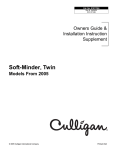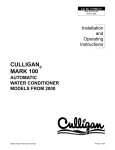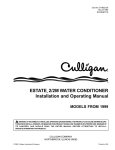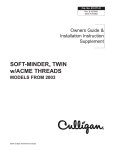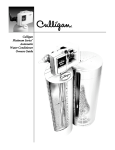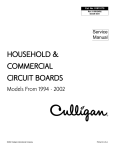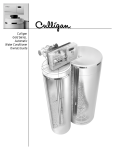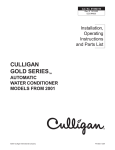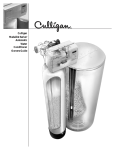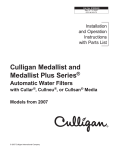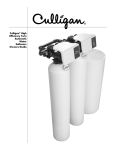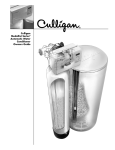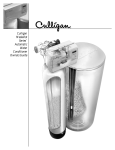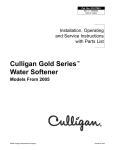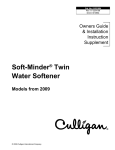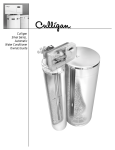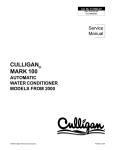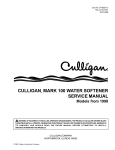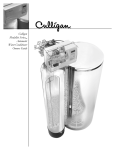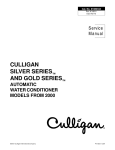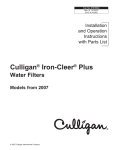Download Culligan Platinum Series Specifications
Transcript
Culligan® Platinum Plus Series Automatic Water Conditioner Owners Guide Thank You And Welcome To Your New World Of Better Living With Culligan Water. The Culligan Platinum Plus Series Water Softeners with Soft-Minder® Meter and Aqua-Sensor® sensing device are tested and certified by WQA against NSF/ANSI Standard 44 for the effective reduction of hardness (calcium and magnesium), barium and radium 226/228 as verified and substantiated by test data. For installations in Massachusetts, Massachusetts Plumbing Code 248 CMR shall be adhered to. Consult your licensed plumber for installation of this system. This system and its installation must comply with state and local regulations. The use of saddle valves is not permitted. If this is your first experience having soft, conditioned water in your home, you’ll be amazed at the marvelous difference it makes. We promise that you’ll never want to be without it again. Congratulations, too, on selecting one of the “first family” of water conditioners in the prestigious Culligan Platinum Series. With Culligan’s many years of knowledge and experience in water treatment, you can be confident that the model you selected has been designed and engineered to provide years of service with a minimum of care and attention. Some localities have corrosive water. A water softener cannot correct this problem and so its printed warranty disclaims liability for corrosion of plumbing lines, fixtures or appliances. If you suspect corrosion, your Culligan Dealer has equipment to control the problem. Sodium Information: Water softeners using sodium chloride for regeneration add sodium to the water. Persons who are on sodium restricted diets should consider the added sodium as part of their overall sodium intake. Attention Culligan Customer: The installation, service and maintenance of this equipment should be rendered by a qualified and trained service technician. Your local independently operated Culligan dealer employs trained service and maintenance personnel who are experienced in the installation, function and repair of Culligan equipment. This publication is written specifically for these individuals and is intended for their use. We encourage Culligan users to learn about Culligan products, but we believe that product knowledge is best obtained by consulting with your Culligan dealer. Untrained individuals who use this manual assume the risk of any resulting property damage or personal injury. i Performance Data Sheets are included in this manual for various Culligan Platinum Plus Series Softener models. Refer to the Performance Data Sheet for your specific softener, as there are slight differences between the models. The softener warranty is located on page 55 of this Owner’s Guide. Table of Contents Specifications . . . . . . . . . . . . . . . . . . . . . . . . . . . . . . . . . . . . . . . . . . . . . . . . . . . . . . . . . 1 Introduction . . . . . . . . . . . . . . . . . . . . . . . . . . . . . . . . . . . . . . . . . . . . . . . . . . . . . . . . . . 2 How your Conditioner Works . . . . . . . . . . . . . . . . . . . . . . . . . . . . . . . . . . . . . . . . . . . . . . 5 Modes of Operation . . . . . . . . . . . . . . . . . . . . . . . . . . . . . . . . . . . . . . . . . . . . . . . . . . . . 7 Preparation . . . . . . . . . . . . . . . . . . . . . . . . . . . . . . . . . . . . . . . . . . . . . . . . . . . . . . . . . . 8 Installation . . . . . . . . . . . . . . . . . . . . . . . . . . . . . . . . . . . . . . . . . . . . . . . . . . . . . . . . . . 10 Programming . . . . . . . . . . . . . . . . . . . . . . . . . . . . . . . . . . . . . . . . . . . . . . . . . . . . . . . . 18 Statistic Functions . . . . . . . . . . . . . . . . . . . . . . . . . . . . . . . . . . . . . . . . . . . . . . . . . . . . . 24 Final Start-Up . . . . . . . . . . . . . . . . . . . . . . . . . . . . . . . . . . . . . . . . . . . . . . . . . . . . . . . . 25 Salt, Supply, Usage and Service . . . . . . . . . . . . . . . . . . . . . . . . . . . . . . . . . . . . . . . . . . . 28 Care and Cleaning of your Water Conditioner . . . . . . . . . . . . . . . . . . . . . . . . . . . . . . . . . 29 Recommended Preventative Maintenance . . . . . . . . . . . . . . . . . . . . . . . . . . . . . . . . . . . . . 29 To Clean Out the Salt Storage Tank . . . . . . . . . . . . . . . . . . . . . . . . . . . . . . . . . . . . . . . . . 30 Sanitizing Procedure . . . . . . . . . . . . . . . . . . . . . . . . . . . . . . . . . . . . . . . . . . . . . . . . . . . 31 Things to Check Before you call for Service . . . . . . . . . . . . . . . . . . . . . . . . . . . . . . . . . . . 32 Error Codes . . . . . . . . . . . . . . . . . . . . . . . . . . . . . . . . . . . . . . . . . . . . . . . . . . . . . . . . . 33 When and How to Bypass your Water Conditioner . . . . . . . . . . . . . . . . . . . . . . . . . . . . . . 34 Culligan Platinum Plus Series 10” Water Softener with Soft-Minder® Meter PDS . . . . . . . . . . 35 Culligan Platinum Plus Series 10” Water Softener with Aqua-Sensor® Sensing Device PDS . . . 36 Culligan Platinum Plus Series 12” Water Softener with Soft-Minder® Meter PDS . . . . . . . . . . 37 Culligan Platinum Plus Series 12” Water Softener with Aqua-Sensor® Sensing Device PDS . . . 38 Culligan Platinum Plus Series 14” Water Softener with Soft-Minder® Meter PDS . . . . . . . . . . 39 Culligan Platinum Plus Series 14” Water Softener with Aqua-Sensor® Sensing Device PDS . . . 40 Culligan Platinum Plus Series 16” Water Softener with Soft-Minder® Meter PDS . . . . . . . . . . 41 Culligan Platinum Plus Series 16” Water Softener with Aqua-Sensor® Sensing Device PDS . . . 42 Parts List . . . . . . . . . . . . . . . . . . . . . . . . . . . . . . . . . . . . . . . . . . . . . . . . . . . . . . . . . . . . 44 Records and Data . . . . . . . . . . . . . . . . . . . . . . . . . . . . . . . . . . . . . . . . . . . . . . . . . . . . . 54 Warranty . . . . . . . . . . . . . . . . . . . . . . . . . . . . . . . . . . . . . . . . . . . . . . . . . . . . . . . . . . . 55 ii Control Valve Overall Conditioner Height Media Tank Design Media Tank Dimensions (Dia x Ht) Salt Storage Tank Dimensions (Dia x Ht) Exchange Media, Type and Quantity Underbedding, Type and Quantity Exchange Capacity @ Salt Dosage Per Recharge Efficiency rated dosage1 Freeboard to Media2 Freeboard to Underbedding3 Salt Storage Capacity Rated Service Flow @ Pressure Drop Total Hardness, Maximum Total Iron, Maximum Hardness to Iron Ratio, Minimum Operating Pressure Operating Pressure (Canada) Operating Temperature Electrical Requirements Electrical Power Consumption, Min/Max Drain Flow, Maximum4 Recharge Time, Average Recharge Water Consumption, Average5 5 10” Model 1 1/4” 5-cycle Reinforced Thermoplastic 62 in 12” Model 1 1/4” 5-cycle Reinforced Thermoplastic 60 in 14” Model 1 1/4” 5-cycle Reinforced Thermoplastic 73 in 16” Model 1 1/4” 5-cycle Reinforced Thermoplastic 73 in Quadra-Hull® Quadra-Hull® Quadra-Hull® Quadra-Hull® 10 x 54 in 12 x 52 in 14 x 65 in 16 x 65 in 18 x 43 in 18 x 43 in 24 x 40 in 24 x 40 in Cullex® Media, 1.5 ft3 Cullex® Media, 2.0 ft3 Cullex® Media, 3.0 ft3 Cullex® Media, 4.0 ft3 Cullsan® Underbedding, 15 lb 28,210 gr @ 6.0 lb 38,260 gr @ 12.0 lb 45,338 gr @ 18.0 lb 4,702 gr/lb @ 6 lb salt dosage 14.5 in Cullsan® Underbedding, 20 lb 31,952 gr @ 7.0 lb 53,438 gr @ 16.0 lb 62,941 gr @ 24.0 lb 4,565 gr/lb @ 7 lb salt dosage 16 in Cullsan® Underbedding, 25 lb 56,420 gr @ 12.0 lb 76,520 gr @ 24.0 lb 90,676 gr @ 36.0 lb 4,702 gr/lb @ 12 lb salt dosage 25 in Cullsan® Underbedding, 30 lb 63,904 gr @ 14.0 lb 106,876 gr @ 32.0 lb 125,885 gr @ 48.0 lb 4,565 gr/lb @ 14 lb salt dosage 25 in 47.5 in 46 in 59 in 59 in 375 lb 375 lb 600 lb 600 lb 14.9 gpm @ 15 psi 19.5 gpm @ 15 psi 20.5 gpm @ 15 psi 22.9 gpm @ 15 psi 99 gpg 99 gpg 99 gpg 99 gpg 5 ppm 5 ppm 5 ppm 5 ppm 8 gpg to 1 ppm 8 gpg to 1 ppm 8 gpg to 1 ppm 8 gpg to 1 ppm 20-125 psi 20-125 psi 20-125 psi 20-125 psi 20-90 psi 20-90 psi 20-90 psi 20-90 psi 33-120°F 33-120°F 33-120°F 33-120°F 24V/60 Hz 24V/60 Hz 24V/60 Hz 24V/60 Hz 3 Watts/35 Watts 3 Watts/35 Watts 3 Watts/35 Watts 3 Watts/35 Watts 2.0 gpm 3.5 gpm 5.0 gpm 6.0 gpm 85 min 84 min 82 min 96 min 54 gal 80 gal 181 gal 183 gal 1 The efficiency rated dosage is only valid at the stated salt dosage and maximum service flow rate and is efficiency rated according to NSF/ANSI 44. 2 Measured from top of media to top surface of tank threads. (backwashed and drained). 3 Measured from top of underbedding to top surface of tank threads. 4 Backwash at 120 psi (830 kPa). 5 10 minute backwash, 6 lb 10” model, 7 lb. 12” model, 12 lb. 14” model or 14 lb. 16” model salt dosage. Performance Specifications Introduction Read this Manual First Before you operate the Culligan Platinum Plus Series Water Softening System, read this manual to become familiar with the device and its capabilities. Watch for Special Paragraphs Please read the special paragraphs in this manual. Examples are shown below. Safe Practices Throughout this manual there are paragraphs set off by special headings. Note: Check and comply with your state and local codes. You must follow these guidelines. For installations in Massachusetts, Massachusetts Plumbing Code 248 CMR shall be adhered to. Consult your licensed plumber for installation of this system. This system and its installation must comply with state and local regulations. The use of saddle valves is not permitted. Note: Note or Notice is used to emphasize installation, operation or maintenance information which is important, but does not present any hazard. Example: Note: The nipple must extend no more than 1 inch above the cover plate. Caution! Caution is used when failure to follow directions could result in damage to equipment or property. Example: Caution! Disassembly while under water pressure can result in flooding. WARNING! Warning is used to indicate a hazard which could cause injury or death if ignored. Example: Warning! Electrical Shock Hazard! Unplug the unit before removing the cover or accessing any internal control parts. Serial Numbers The control valve serial number is located on the back of the timer case. The media tank serial number is located on the top surface of the tank. Note: Do not remove or destroy the serial number. It must be referenced on request for warranty repair or replacement. This publication is based on information available when approved for printing. Continuing design refinement could cause changes that may not be included in this publication. Products manufactured and marked by Culligan International Company (Culligan) and its affiliates are protected by patents issued or pending in the United States and other countries. Culligan reserves the right to change the specifications referred to in this literature at any time, without prior notice. Culligan, Aqua-Sensor, Tripl-Hull, Flo-Pak and Soft-Minder are trademarks of Culligan International Company or its affiliates. It’s All So Easy, So Economical, So Efficient, So Enjoyable! Kind To Skin And Complexion Introduction (cont.) Soft water will help prevent red, itchy or dry skin because there are no hardness impurities to cause soreness, no soap curd to coat the skin. Shaving is easier, smoother - either with blade or electric shaver. Bathing And Showering You’ll use far less soap with conditioned water. Use your soap very sparingly - not as you did before soft water. Just a quick rinse removes all lather, leaving your skin pleasantly smooth and silky - because now it’s free of sticky soap curd and film. Saves Washing Costs. Helps Control Environmental Pollution Soft water washes whiter and cleaner with less soap or detergent. Because the hardness impurities are removed, your soap can concentrate solely on washing. People usually find that they can reduce the amount of soap they use substantially. If you normally used a cup per wash load with hard water, try using only 1/3 cup depending on the size of your wash load and the degree of soil. Different amounts are required, but you can use less with softened water. An added bonus is the fact that your washable fabrics will last longer. Super Hair Conditioning Soft water is great for scalp and hair care. No insoluble deposits are formed. Hair is shinier, softer, more manageable. Reduce the amount of shampoo you have normally used. Dishes Are A Delight Washed by hand or in a dishwasher, glassware, dishes and silver wash cleaner, easier. Follow your dishwasher manufacturer’s instructions. Soft water promotes sanitation because no greasy hard water film can form to collect or harbor bacteria. Easier Housekeeping, Gleaming Fixtures You’ll be amazed at the marvelous difference. Just a swish of the cloth, and the bathtub or shower and fixtures are clean and sparkling. Imagine, no scouring! No hard water scum to cause rings, streaks, spots and stains. To keep their gleaming luster, simply wipe fixtures with a towel after use. Formica, tile, walls, floors, woodwork surfaces clean easier, stay clean longer. You’ll save on cleaning aids and save on time. Introduction (cont.) Saves Water-Heating Energy, Helps Water-Using Appliances Soft water reduces the formation of rock-like hard water scale which encrusts water heaters, hot water pipes, shower heads, and water-using appliances. This scale can cause premature maintenance and failure. Elimination of hard water also provides substantial energy savings because scale acts as an insulator, wasting electricity or gas used to heat water. Savings Galore A water conditioner is frequently referred to as “the appliance that pays for itself”. You’ll find that your savings on soaps, detergents, cleaning aids, and personal care products will help your family’s household budget. And if you place a price on your time, you’ll be most happy with the time saved by your new family servant. Water For Lawns And Household Plants If possible, lawn sprinkling faucets should be supplied with hard water primarily because it is uneconomical to soften so much water. Household plants are much more sensitive than lawns with respect to the kind of water which is best. First, because they receive no rainfall and, second, there is little or no drainage of the soil. Preferably they should be watered with rainwater or water which is low in mineral content such as distilled or demineralized water. Softened water is not recommended for house plants because a build-up of sodium in the soil may interfere with efficient absorption of water by the plant root system. Additional information may be obtained from your independently operated Culligan dealer. Why Water Gets Hard And How It’s Softened All of the fresh water in the world originally falls as rain, snow, or sleet. Surface water is drawn upward by the sun, forming clouds. Then, nearly pure and soft as it starts to fall, it begins to collect impurities as it passes through smog and dust-laden atmosphere. And as it seeps through soil and rocks it gathers hardness, rust, acid, unpleasant tastes and odors. How Your Water Conditioner Works Water hardness is caused primarily by limestone dissolved from the earth by rainwater. Because of this, in earlier times people who wanted soft water collected rainwater from roofs in rain barrels and cisterns before it picked up hardness from the earth. Some localities have corrosive water. A softener cannot correct this problem and so its printed warranty disclaims liability for corrosion of plumbing lines, fixtures or appliances. If you suspect corrosion, your Culligan Man has equipment to control the problem. Iron is a common water problem. The chemical/physical nature of iron found in natural water supplies is exhibited in four general types: 1. Dissolved Iron - Also called ferrous or “clear water” iron. This type of iron can be removed from the water by the same ion exchange principle that removes the hardness elements, calcium and magnesium. Dissolved iron is soluble in water and is detected by taking a sample of the water to be treated in a clear glass. The water in the glass is initially clear, but on standing exposed to the air, it may gradually turn cloudy or colored as it oxidizes. 2. Particulate Iron - Also called ferric or colloidal iron. This type of iron is an undissolved particle of iron. A softener will remove larger particles, but they may not be washed out in regeneration effectively and will eventually foul the ion exchange resin. A filtering treatment will be required to remove this type of iron. 3. Organic Bound Iron - This type of iron is strongly attached to an organic compound in the water. The ion exchange process alone cannot break this attachment and the softener will not remove this type of iron. 4. Bacterial Iron - This type of iron is protected inside a bacteria cell. Like the organic bound iron, it is not removed by a water softener. When using a softener to remove both hardness and dissolved iron it is important that it regenerates more frequently than ordinarily would be calculated for hardness removal alone. Although many factors and formulas have been used to determine this frequency, it is recommended that the softener be regenerated when it has reached 50 - 75% of the calculated hardness alone capacity. This will minimize the potential for bed fouling. (Iron removal claims have not been verified by the Water Quality Association or Underwriters Laboratories.) If you are operating a water softener on clear water iron, regular resin bed cleaning is needed to keep the bed from coating with iron. Even when operating a softener on water with less than the maximum of dissolved iron, regular cleanings should be performed. Clean every six months or more often if iron appears in your conditioned water supply. Use resin bed cleaning compounds carefully following the directions on the container. Caution! Do not use where the water is microbiologically unsafe or with water of unknown quality without adequate disinfection before or after the unit. The Culligan Process Your Culligan water conditioner consists of three basic components, (A) the Control Valve, (B) the Mineral Tank, and (C) the Brine System. A. The exclusive Culligan control valve automatically performs a variety of tasks that are necessary for the proper operation of your water conditioner. These tasks, commonly referred to as cycles or operating positions, are Service, Regeneration, and Brine Refill. 1. Service: While the control valve is in the “Service cycle”, hard water is directed down through the column of Cullex® resin where hardness minerals are removed from the water. The softened water is then directed into your household plumbing lines. The ability of the Cullex resin to remove hardness minerals needs to be periodically replenished; this is referred to as . . . 2. Regeneration: While the control valve is in the “Regeneration cycle”, water is first directed up through the column of Cullex resin to flush accumulated sediment out of the resin and down the drain. Then, the regenerant brine solution is slowly drawn from the bottom of the salt storage tank of the Brine System and is directed down through the column of Cullex resin, restoring the ability of the resin to remove hardness minerals from your water supply. Once completed, the regeneration cycle is followed by . . . 3. Brine Refill: While the control valve is in the “Brine Refill cycle”, a predetermined amount of water is directed to the salt storage tank of the Brine System so that additional salt can be dissolved to provide the brine solution that will be needed for the next regeneration cycle. B. The Mineral Tank contains the Cullex resin column, Cullsan® underbedding, and an outlet manifold. The number of gallons of hard water that can be softened by the Cullex resin column before it needs regeneration is called the “capacity” of the resin column, and depends upon the amount of hardness minerals in each gallon of water (expressed as grains per gallon) and upon the amount of regenerant brine solution (expressed as pounds of salt) passed through the resin column during regeneration. Your Culligan service person, taking into account the hardness of your water and the amount A. Control of softened water your household may Valve reasonably expect to use each day, has carefully established how often the softener will regenerate and how much salt will be B. Mineral Tank used for each regeneration. This will ensure C. Brine System that all of your soft water needs will be fulfilled Manifold without using an excessive amount of salt. C. The Brine System consists of a salt storage container and hydraulic Dubl-Safe™ valve. The salt storage container holds the salt that is used to make the regenerant brine solution. The hydraulic Dubl-Safe valve limits the amount of water that is returned to the salt storage tank during the brine refill cycle. Since a predetermined amount of salt is dissolved with each brine refill cycle, the salt must be periodically replenished in order to maintain efficient operation. Your Culligan service person will be able to tell you about how often salt must be added to the salt storage container. Freeboard Brine Tank Cover Brine Valve Resin (Cullex) Gravel Underbedding Distributor Brine Tank Brine Chamber Salt Plate Water Meter Mode In water meter mode, the controller keeps track of the quantity of water that has flowed through the resin bed. Based on the influent water hardness and the hardness capacity of the resin bed, a service life expectancy in the quantity of softened water is calculated and programmed into the control. When the set point is reached, regeneration is triggered. In delay regeneration mode, if the predict mode is turned on, the average daily water usage will be compared to the remaining capacity at the regeneration delay time to predict if another day’s water usage can occur before requiring regeneration. If enough capacity is not present then the regeneration will occur at that time. If the predict mode is not selected the regeneration will start at time of regeneration. In immediate mode the regeneration starts when the capacity is exhausted. If time clock backup is set and the capacity has not been exhausted but the days since last regen is greater than time clock backup setting, the softener will immediately regenerate. Modes of Operation Aqua-Sensor Mode The Aqua-Sensor is a conductivity probe that senses when a hardness front passes through the resin bed. It functions independently of the influent water hardness so therefore, is useful in conditions when the influent water hardness varies throughout the year. It provides for the most efficient mode of operation. In addition to sensing when a resin bed is exhausted, it can also be used to determine when the brine solution is rinsed from the resin bed during the Brine Draw/ Slow Rinse cycle triggering the control to move to fast rinse. This patented feature provides water savings by optimizing the amount of rinse water required to completely rinse out the resin bed. Manual Regeneration Pressing and holding the regen button for 5 seconds will initiate an immediate regeneration. The beeper will give one beep at the start of manual regeneration (when the motor starts to turn). In delay mode, pressing and releasing the regen button will light the regen icon for regeneration to occur at the set delay time. Pressing and releasing the regen button again will turn off the regen icon. Predict Mode The Predict Mode is used with the flow meter to determine the optimum regeneration point. Before the regeneration starts, the control will compare the remaining capacity value with the average daily water use. If the average daily water usage is less than the reserve capacity, the controller will wait 24 more hours before regeneration. If the reserve capacity is less than the average daily water usage, the control will initiate regeneration. This works in delay mode only. At any time, if the total capacity value is reached, the control will initiate an immediate regeneration. Efficiency Mode Water softeners historically use an optimum time range to control the Regeneration cycle steps, with a minimum and maximum time required to perform each step dependent on the salt being used, the hardness total and iron level. Culligan typically uses the maximum time range to insure effective Regeneration. However, if the iron content of the water to be softened is zero, and the hardness level is less than 20 gpg, Culligan has developed a new set of regeneration times geared to reducing salt and water usage. These times are defined under a new operating mode coined “Efficiency Mode”. Compared to the present time values used, these new regeneration times and salt dosages are considerably less. Preparation Component Description The water conditioner is shipped from the factory in a minimum of three cartons. Remove all components from their cartons and inspect them before starting installation. Control Valve Assembly - Includes the 5-cycle regeneration control valve and the Accusoft® Plus Microprocessor. Small parts packages will contain additional installation hardware, and the conditioner Owner’s Guide. Media Tank - Includes Quadra-Hull® media tank complete with Cullex® ion exchange resin, underbedding and outlet manifold (12”, 14” and 16” tanks are shipped without media). Salt Storage Tank Assembly - Includes salt storage container with support plate and DublSafe™ brine refill valve and chamber. Bypass Valve - Includes the molded bypass valve, the interconnecting couplings, and the assembly pins. Tools and Materials Note: Check and comply with your state and local codes. You must follow these guidelines. For installations in Massachusetts, Massachusetts Plumbing Code 248 CMR shall be adhered to. Consult your licensed plumber for installation of this system. This system and its installation must comply with state and local regulations. The use of saddle valves is not permitted. The following tools and supplies will be needed, depending on installation method. All Installations • • • • • • Safety glasses Phillips screwdrivers, small and medium tip. Gauge assembly (PN 00304450 or equivalent) Silicone lubricant (PN 00471507 or equivalent) - Do Not Use Petroleum-Based Lubricants A bucket, preferably light-colored Towels Special Tools • • • • Torch, solder and flux for sweat copper connections Use only lead-free solder and flux for all sweat-solder connections, as required by state and federal codes. Threading tools, pipe wrenches and thread sealer for threaded connections. Saw, solvent and cement for plastic pipe connections. Materials • • • • • • Brine line, 3/8” (PN 01009819 or equivalent) Drain line, 1/2” (PN 00303082, gray, semi-flexible; or PN 00-3319-46, black, semi-rigid; or equivalent) Thread sealing tape Pressure reducing valve (if pressure exceeds 125 psi [860 kPa], PN 00490900 or equivalent) Pipe and fittings suited to the type of installation Water softener salt (rock, solar or pellet salt formulated specifically for water softeners) Application Water quality - Verify that raw water hardness and iron are within limits. Note the hardness for setting the salt dosage and recharge frequency. Preparation (cont.) Iron is a common water problem. The chemical/physical nature of iron found in natural water supplies is exhibited in four general types Dissolved Iron, Particulate Iron, Organic Bound Iron and Bacterial Iron. Hardness sample kits are available through your local Culligan dealer. Pressure - If pressure exceeds 125 psi (860 kPa), install a pressure reducing valve (see materials checklist). On private water systems, make sure the minimum pressure (the pressure at which the pump starts) is greater than 20 psi (140 kPa). Adjust the pressure switch if necessary. Caution! Do not use where the water is microbiologically unsafe or with water of unknown quality adequate disinfection before or after the unit. Caution! The use of a pressure reducing valve may limit the flow of water in the household. Temperature - Do not install the unit where it might freeze, or next to a water heater or furnace or in direct sunlight. If installing in an outside location, you must take the steps necessary to assure the softener installation plumbing, wiring, etc. areas well protected from the elements (sunlight, rain, wind, heat, cold), contamination, vandalism, etc. as when installed indoors. Location Space requirements - Allow 6-12 inches (15-30 cm) behind the unit for plumbing and drain lines and 4 feet (1.3 meters) above for service access and filling the salt container. Floor surface - Choose an area with solid, level floor free of bumps or irregularities. Bumps, cracks, stones and other irregularities can cause the salt storage tank bottom to crack when filled with salt and water. Drain facilities - Choose a nearby drain that can handle the rated drain flow (floor drain, sink or stand pipe). Refer to the Drain Line Chart, Table 3 (page 15), for maximum drain line length. Note: Most codes require an anti-siphon device or air gap. Observe all local plumbing codes and drain restrictions. The system and installation must comply with all state and local laws and regulations. Electrical facilities - A 10-foot cord and wall mount plug-in transformer are provided. The customer should provide a receptacle, preferably one not controlled by a switch that can be turned off accidentally. Observe local electrical codes. Note: The softener works on 24 volt - 60 Hz electrical power only. Be sure to use the included transformer. Be sure the electrical outlet and transformer are in an inside location to protect from moisture. Properly ground to conform with all governing codes and ordinances. Note: P.N. 01012956 and P.N. 01014897 plug-in transformer are rated for indoor installations only. P.N. 01015972 plug-in transformer is rated for indoor/outdoor installations. (Non-Aqua-Sensor) Installation Note: Read this section entirely before starting the installation. Follow all applicable plumbing and electrical codes. With the exception of media containers, open the remaining containers, remove all the components, and inspect them before starting installation. Placement Refer to figure 1 for system placement. • Set the media tank on a solid, level surface near water, drain and electrical facilities. • Set the brine system on a flat, smooth, solid surface as near the media tank as possible. Treated Water Out Drain Line Hard Water In To Hose Bibs Softener Heater Air Gap Brine Tank Water Meter or Pump Figure 1 Tank Assembly Before the unit can be connected to the plumbing the manifold distributors must be assembled Caution! DO NOT lay the tank down unless a suitable lifting device is available. Personal injury and damage to the unit can result if dropped. and the underbedding and resin must be loaded into the tank for 12”, 14” and 16” tanks. Position of the Mineral Tank(s) Determine the location for the mineral tanks(s) prior to loading, since they will be difficult to move after the underbedding and gravel are loaded. 10 Installation (cont.) Loading the Tank (12”, 14” and 16” Tanks) 1. Position the tank so that the Culligan® logo is in the front. 2. Remove the inlet strainer. 3. Install the outlet manifold into the tank (Figure 2). 4. Cover the top of the manifold with a clean rag. 5. Using a large-mouth funnel, load the Culligan underbedding through the top of the tank. Caution! DO NOT allow the outlet manifold to move when loading the media. The manifold must remain vertical to ensure a good seal at the gasket. Rap the tank near the bottom with a rubber mallet to level the sand. 6. Aqua-Sensor® Installation (optional device) A. Measure the sensor cable length as shown in Figure 2 and Table 1 (the Aqua-Sensor® cord is set at the factory for a 9” tank). B. Loosen the small Aqua-Sensor® Plug, a needle-nose pliers works best (figure 3). C. Moisten the cable sheath and slide the cable grip up or down to the proper cable length. D. Tighten the small Aqua-Sensor® plug so that the fitting cannot slide along the cable. Figure 2 Note: There must be no kinks or bends in the cable. Small Aqua-Sensor® Plug E. Insert the probe and cable through the Aqua-Sensor port. ® 7. Load the tank with the Cullex® ion exchange resin. Leveling is not required. Remove the funnel. 8. Install the inlet strainer making sure to thread the strainer in until it bottoms out on the thread. Failure to install the strainer correctly can cause the control to leak. Dimension “X” is the exposed length the Aqua-Sensor® cord (cord length from the Aqua-Sensor® plug to the circuit board connector). You can then verify the Aqua-Sensor® probe is inserted to the proper depth by confirming dimension “X” is at the corrected length. Model Figure 3 X Y 10” Quadra-Hull Tank 30 1/2” 44” 12” Quadra-Hull Tank 32 1/2” 42” 14” Quadra-Hull Tank 22 1/2” 52” 16” Quadra-Hull™ Tank 22 1/2” 52” ™ ™ ™ Table 1 11 Installation (cont.) Mount the Control Valve See Figure 4 for a visual on mounting the control valve to the tank. • Remove and discard the protective cover in the tank neck. • Install the inlet strainer making sure to thread the strainer in until it bottoms out on the thread. Failure to install the strainer correctly can cause the control to leak. • Lubricate the O-ring on the valve body lightly with silicon lubricant. Note: Do not use petroleum based lubricant, for this will cause swelling of rubber parts. • Align the outlet manifold with the center opening in the control valve. Note: Make sure to push the valve straight down onto the manifold. If the valve is cocked it may cause the O-ring to slip off the manifold. • Screw the tank adapter into the tank until the adapter bottoms out on the tank flange. Note: The adapter only needs to be tightened hand-tight to the tank flange. • Assemble the O-rings, located in the parts pack, to the tank adapter. • The valve adapter O-ring sits on the first step on the adapter. See Figure 5. Note: Do not push the top O-ring down to the flange surface on the adapter. Note: The larger of the two O-rings in the parts pack goes between the adapter and the valve, do not stretch the smaller O-ring onto the top of the tank adapter. • Lubricate only the top O-ring on the tank adapter, and the outlet manifold O-ring with silicone lubricant. • Position the unit with the inlet and outlet connections to the rear. • Align the manifold with the center opening in the valve, and press the valve onto the adapter firmly. Valve - Adapter O-Ring Tank Adapter Tank Clamp Tank Clamp Adapter - Tank O-Ring Figure 4 Note: Make sure to push the valve straight down onto the manifold. If the valve is cocked, it may cause the O-ring to slip off the manifold. • Assemble the tank clamp to the control, and tighten the clamp screw. Note: The clamp and valve will be able to rotate on the tank until pressure is applied. 12 Figure 5 Installation (cont.) Flow Control Eductor Nozzle Listed below is the recommended eductor nozzle to be used at various salt dosages. Tank Injector Draw Rate DLFC (gpm) BLFC (gpm) 10 x 54 1 - white 12 x 52 1 - white 0.38 2 0.25 0.38 3.5 0.25 14 x 65 16 x 65 4 - green 0.78 5.0 0.50 4 - green 0.78 6 0.50 Table 2 - Flow Restrictors Refer to Figure 6 for a visual on changing the eductor nozzle and the backwash flow control. Injector Cover Injector Assembly Injector Screen Brine Clip Drain Elbow Flow Control Drain Clip Injector Clip Brine Fitting Tube Ferrule Brine Fitting Nut Tube Insert Figure 6 Eductor Nozzle Replacement: • Remove the injector clip on the eductor cap and remove the cap. • Remove the injector assembly. • Remove the injector screen from the assembly • Remove the injector assembly that is shipped inside the control and replace it with the proper assembly as per Table 2. • Reverse the procedure to reassemble. 13 Installation (cont.) Backwash Flow Control Replacement: • Remove the drain clip and pull the drain elbow straight off. • Remove the backwash flow control located behind the elbow. • Install the correct backwash flow control. • Reverse the procedure to reassemble. Note: The number on the flow control should face into the valve body. Note: Dip switch #5 is to be in the “off ” position for 10” and 12” Tanks (0.25 gpm refill flow control). Dip switch 5 is to be in the “on” position for 14” and 16” tanks (0.50 gpm brine refill flow control). Plumbing Connections Shipped with each softener is a Culligan® bypass valve, which is used to connect the softener to the plumbing system. The bypass allows the softener to be isolated from the water service line if service is necessary while still providing water to the home. See the parts list for connectors that are available. Caution! Close the inlet supply line and relieve system pressure before cutting into the plumbing! Flooding could result if not done! Caution! When making sweat connections, use care to keep heat away from the plastic nuts used to connect the plumbing to the bypass. Damage to these components may otherwise result. Bypass Valve Installation The bypass valve connects directly to the control valve with a pair of couplings and two assembly pins. Lubricate all O-rings on the couplings with silicone lubricant. The bypass valve is in the service position when the handle is rotated as far back as possible (See figures 7a and 7b). Note: If the ground from the electrical panel or breaker box to the water meter or underground copper pipe is tied to the copper water lines and these lines are cut during installation of the bypass Figure 7a Figure 7b valve, an approved grounding strap must be used between the two lines that have been cut in order to maintain continuity. The length of the grounding strap will depend upon the number of units being installed. In all cases where metal pipe was originally used and is later interrupted by the bypass valve to maintain proper metallic pipe bonding, an approved ground clamp c/w not less than #6 copper conductor must be used for continuity. Check your local electrical code for the correct clamp and cable size. 14 Caution! To bypass the valve, turn bypass knob on both sides of the valve to bypass position (see figure 7b). When returning to service, put the inlet into service before the outlet. Installation (cont.) Drain Line Connection Refer to Table 3, for drain line length and height limitations. • Remove 1/2” pipe clamp from the small parts pack included with the control. • Route a length of 1/2” drain line from the drain elbow to the drain. • Fasten the drain line to the elbow with the clamp. • Secure the drain line to prevent its movement during regeneration. When discharging into a sink, or open floor drain, a loop in the end of the tube will keep it filled with water and will reduce splashing at the beginning of each regeneration. Note: Waste connections or drain outlets shall be designed and constructed to provide for connection to the sanitary waste system through an air gap of 2 pipe diameters or 1 inch, whichever is larger. Note: Observe all plumbing codes. Most codes require an anti-siphon device or air gap at the discharge point. The system and installation must comply with state and local laws and regulations. For installations in Massachusetts, Massachusetts Plumbing Code 248 CMR shall be adhered to. Consult your licensed plumber for installation of this system. This system and its installation must comply with state and local regulations. Height of Discharge Above Floor Level Operating Operating Pressure 0 ft (0 m) 2 ft (0.6 m) 4 ft (1.2 m) 6 ft (1.8 m) 8 ft (2.4 m) 10 ft (3 m) 30 psi (210 kPa) 60 ft (18 m) 50 ft (15 m) 30 ft (9 m) 15 ft (5 m) Not allowable Not allowable 40 psi (279 kPa) 100 ft (30 m) 90 ft (27 m) 70 ft (21 m) 50 ft (15 m) 30 ft (9 m) 12 ft (4 m) 50 psi (349 kPa) 145 ft (41 m) 115 ft (35 m) 80 ft (24 m) 80 ft (24 m) 60 ft (18 m) 40 ft (12 m) 100 ft (30 m) 100 ft (30 m) 85 ft (26 m) 60 ft (18 m) 140 ft (43 m) 120 ft (37 m) 60 psi (419 kPa) 80 psi (559 kPa) 100 psi (699 kPa) Normal installation should not require more than 100 ft (30 m) of drain line 150 ft (46 m) Table 3 - Maximum Allowable Drainline Length Fill the Storage Container Fill the salt storage container with water until the level reaches about 1 inch above the salt support plate. Pour salt into the container. Fill with salt to within a few inches of the top. 15 Brine Valve “A” Dimension The Culligan Platinum Plus Series™ unit contains a brine float which can serve as a backup refill shutoff in the event of a failure, such as a power outage when in the refill position. The float level should be set based on the salt dosage setting. Refer to Figure 8 and Appendix A Table 4, page 43. • Remove the nut retaining brine valve to the brine chamber. • Lift the brine valve from the brine chamber. • Set the distance from the top of the filter screen to the base of the float accordingly. The slight difference in height when the float is pulled up or down is negligible. • Re-install the brine chamber and replace the nut. “A” Dimension Installation (cont.) Aqua-Sensor® Probe and Soft-Minder® Meter Connection To connect the probe or meter leads refer to Figure 9 and proceed as follows: • Remove the timer case from the back plate. • Snap the circuit board holding plate off the back plate to provide access to the back of the circuit board. • Remove the plastic plug from the backplate. • Slip the sensor probe lead or meter cable through the hole and toward the circuit board. • Connect the lead to the circuit board. The Aqua-Sensor® probe terminal is labeled “Aqua Sense” while the Soft-Minder® meter terminal is labeled “Flow Meter”. • Pull any excess cable wire back out of the enclosure, and route the wiring inside the enclosure to avoid any interference with moving parts. Dip Switches Locate the strain relief bushing in the parts pack. Place it on the cable at the point of entry to the rear of the timer plate and push it into the hole. Optional Battery • Figure 8 Power Motor 16 Cam Switches Figure 9 AquaSensor® SoftMinder® Meter Installation (cont.) Connect the Brine Line • Measure a length of brine line sufficient to reach from the brine tank to the brine fitting, with no sharp bends. For easier access to the float it is recommended to add an extra four feet (1.3 meters) of length to the brine line. Cut both ends of the brine line squarely and cleanly. • Slip the white nut over one end of the tubing and press the plastic insert into the end of the tubing (Figure 10). Connect to the brine valve and tighten nut. Figure 10 • Remove white nut and plastic insert from the small parts pack. • Slip the white nut over one end of the tubing and press the plastic insert into the end of the tubing (Figure 10). Connect to the brine connection on the valve and tighten nut Electrical Connection The Aqua-Sensor® probe (Figure 11) requires a 2.5 VAC power source. This source is provided via two of the posts on the 24V/2.5V transformer. Two leads from the transformer must be wired to the 2.5 VAC terminal on the circuit board. The wire connector from the Aqua-Sensor® probe is simply plugged in the circuit board (Figure 12). White Red 24 VAC Power Black Figure 11 2.5 VAC AquaSensor® Power Blue Power to circuit board, 2.5 VAC for Aqua-Sensor® installation Figure 12 17 Programming Power Loss The AccuSoft® circuit board is equipped with a Hi-Cap Capacitor and EEPROM memory chip. The capacitor is capable of maintaining the time, for at least one day, in the event of a power outage. The EEPROM ensures that the individual programming parameters of your softener are not lost. If the power outage lasts long enough to drain the Hi-Cap Capacitor, the control will flash “12:00 PM” when power is returned to the control. The unit will continue to keep time from the moment power is restored, and will initiate a full regeneration at the preset regeneration time. The time of day will need to be reset in order to return the regeneration to its preset time. If you live in an area where power outages occur with a regular frequency, a battery backup option is available for ensuring that the time of day is properly maintained. Contact your Culligan Dealer for more information. Display Program Key Regeneration Key Program Regen Information Press Regen once to begin regeneration tonight, Or hold for immediate regeneration. Setting Time Of Day 1. 2. 3. 4. Toggle Up Toggle Down Press Information until 'tod' is displayed. Use arrow keys to adjust minutes. Press Regen once then adjust hours. C ontinue to press Information to exit menu & save. Display Back lit LCD display. Program Key Depress to enter and move through the programming steps. Press and hold the key for three (3) seconds to initiate an immediate regeneration. Regeneration Key Information Key Toggle Down Key Toggle Up Key 18 Information Key When pressed during programming the time of day, this key will allow the user to toggle between the hours and minutes setting of timing program segments. Each time depressed, the Information key will display statistical information such a flow rate, time of day. Use with the Toggle Down key to display other statistical information. In the programming mode this key will move the user through the programming function in a descending mode. If depressed for greater than three seconds, the rate at which the display scrolls through data will increase. In the programming mode this key will move the user through the programming function in an ascending mode. If depressed for greater than three seconds, the rate at which the display scrolls through the data will increase. This key will also allow the user to manually step through the cycles of regeneration. The Culligan® AccuSoft® Plus circuit board controls all the softener functions. These settings are programmed at the time of installation. The following is a list of all the microprocessor functions in the event that any of the settings need to be adjusted. Programming (cont.) A further description of each programming setting and the corresponding display is outlined below. For a display that has an icon that is displayed solid for the 2 second time period prior to bringing up the settings, the settings menu can be reached prior to the two second time out by pressing the “Up” or “Down” key. • Beeper Setting - This setting is used to turn the beeper on or off for each key press actuation. The display will show “bEEP X” where X is either “Y” or “N”. The “Y” or “N” will be toggled with the “Up” and “Down” keys. Setting the Beep option to “N” will only disable the beeper for key press actuation. The beeper will still be active for error and alarm codes. Pressing the “Program” key will save the setting and move to the next programming step. • Time of Day - This setting is used to program the current time of day. When in this step the display will first show “tod” for two seconds. After “tod” is displayed, “12:00 PM” will display (or the current set time if already programmed) and the minutes will flash. The minutes are adjusted with the “Up” or “Down” key until the correct value is displayed. Press the “Regen” key to flash the hours. Adjust with the “Up” or “Down” key until the correct time is displayed. Minutes Flashing Hours Flashing Pressing the “Program” key will save setting and move to the next programming step. Pressing “Regen” will move back to the minutes adjust. • Time of Regeneration - This setting is used to program the time at which a regeneration is to occur in the delay mode, or in immediate mode with time clock backup on. The display will first show “tor” for two seconds. After “tor” is shown the display will then show the default of 2:00 AM (or the current programmed time of regeneration if already set). The time can be adjusted in 30 minute increments by pressing the “Up” or “Down” keys. Pressing the “Program” key will save the setting and move to the next programming step. Time Flashing 19 Programming (cont.) • Regeneration Interval - This setting is used to set the days between regeneration in time clock mode. It is also active in meter or Aqua-Sensor® mode if the time clock backup DIP switch # 10 is set to on. The display will show “REGEN” icon and “dAYS” as well as the numbers to change. Adjust the value with the “Up” or “Down” keys. Pressing the “Program” key will save the setting and move to the next programming step. • Hardness Setting - This setting is used to set the hardness (grains) of the influent water supply. For English Units the display will first show “Hard” for two seconds and then display the Hardness default (or the previously programmed value). Adjust the value with the “Up” or “Down” keys. (These settings will not get saved to EEPROM until the ‘Program’ key is pressed while at the ‘View’ programming step) • Iron Setting (flow meter only) - This setting is used to set the iron level of the influent water supply. The display will show “Iron” in the left most digits and the iron default setting (or the previously programmed value) in the far right digit. The display will only appear if a flow meter is connected to the circuit board. If the iron level is set to “Y”, the Efficiency Mode is inactive. Adjust the value with the “Up” or “Down” keys. Pressing the “Program” key will temporarily store the setting and move to the next programming step. (This setting will not get saved to EEPROM until the ‘Program’ key is pressed while at the ‘View’ programming step) • Pressure Setting - This setting is used to set the influent water pressure. The display will show “LowP” in the left most digits and the pressure default setting in the far right digit. If the pressure is less than 40 psi, chose “Y”. By choosing “Y” the brine rinse time will be extended. Adjust the value with the “Up” or “Down” keys. Pressing the “Program” key will temporarily store the setting and move to the next programming step. • Salt Type (flow meter only) - This setting is used to select the regeneration salt type (softener mode only). This display will only appear if dip # 4 is off. The display will show “SALt” for 2 seconds. Then display the default ‘NACL’. Pushing the “Up” or “Down” keys will change to ‘KCL’. 20 Pressing the “Program” key will temporarily store the setting and move to the next programming step. (This setting will not get saved to EEPROM until the ‘program’ key is pressed while at the ‘View’ programming step) Programming (cont.) • Efficiency Mode (flow meter only) - Efficiency mode will only be active if the conditions as explained earlier are met (Not available if DIP switch #6 or DIP switch #9 are on). The “EFFICIENCY MODE” Icon will be displayed with a default of “YES”. Toggle between “YES” and “NO” with the “Up” or “Down” key. Pressing the “Program” key will temporarily store the setting and move to the next programming step. (This setting will not get saved to EEPROM until the ‘program’ key is pressed while at the ‘View’ programming step). • Platinum Plus - This setting is used to determine what size tank the control is connected to. The display will first show “5cYc” with the tank size default (or the previously programmed value). Adjust the tank size with the “Up” or “Down” keys. Pressing the “Program” key will temporarily store the setting and move to the next programming step. (This setting will not get saved to EEPROM until the ‘Program’ key is pressed while at the ‘View’ programming step) • View - This setting is used to allow the programmer to view the calculated values for salt dosage, cycle times, batch capacity, and total capacity. These values may be changed at this time. The display will show “VIEW N”. The “Y” or “N” will be toggled with the “Up” and “Down” keys. The default for this item shall always be “N” and does not get saved in EEPROM. The programmer must always toggle to “Y” in order to view these items. Pressing the “Information “ key at this menu will re-calculate outputs based on saved inputs. 9999 99 OOO8 7O Note: “Save” does not appear if no value is changed. If “VIEW Y” is chosen, then pressing the “Program” key will display the value for salt dosage; repeated presses of the program key will display cycle times, batch capacity, and total capacity. Pressing the “Program” key after viewing “Batch” will exit the programming menu.. If “VIEW N” is chosen, then pressing the “Program” key will exit the programming menu. If any values were changed from calculated values, then “SAVE” prompt appears. If “SAVE N” is chosen, the calculated values go back in. The user must choose “SAVE Y” to save custom values. 21 Programming (cont.) • Salt Dosage - This setting is used to set the salt dosage. The display will first show “dOSAGE” for two seconds and then display the default (or previously programmed value). The proper units (lbs or kg) will appear according to dip # 7 setting (English/Metric). Adjust the salt dosage with the “Up” or “Down” keys. KG 3.O Note: This setting also appears during Aqua-Sensor® Programming. Pressing the “Program” key will save the setting and move to the next programming step. • Cycle 1 Time - This setting is used to program the cycle 1 time that is usually backwash. The time of the cycle is kept in minutes. The display will show the “BACKWASH” and “MINS” icons and the cycle time in the right most digits. Adjust the value with the “Up” or “Down” keys. Note: This setting also appears during Aqua-Sensor® Programming. Pressing the “Program” key will save the setting and move to the next programming step. • Cycle 2 Time - This setting is used to set the time in minutes for cycle 2. This cycle is brine draw / slow rinse for softeners. The display will show the “BRINE RINSE” and “MINS” icons and the cycle time in the right most digits. Adjust the value with the “Up” or “Down” keys. Note: This setting also appears during Aqua-Sensor® Programming. Pressing the “Program” key will save the setting and move to the next programming step. • Cycle 3 Time - This cycle is the Fast Rinse for softeners. The display will show the “Fast Rinse” and “Mins” icons and the cycle time in the far right digits. Adjust the value with the “Up” and “Down” keys. Pressing the “Program” key will move to the next programming step. • Cycle 4 Time - This cycle is the Refill for softeners. The display will show the “Refill” and “Mins” icons and the cycle time in the far right digits. Note: This setting CAN NOT be adjusted! 22 Pressing the “Program” key will move to the next programming step. • Total Capacity Set Point (Max Capacity) - This setting is used to program a value that corresponds to the maximum capacity that can be expected from a unit before it is completely exhausted. If the unit reaches this set point an immediate regeneration will occur . This setting will only appear if a flow meter is connected to the circuit board. Adjust the value with the “Up” or “Down” keys. The display will show the “REGEN” icon and “MAXCAP” for two seconds and then display the “REGEN” and “GALLONS” or “LITERS” (depending on DIP switch # 7 setting) icons and the setting numbers to adjust. Programming (cont.) 9999 99 Note: “Maxcap” can not be set lower than “Batch”. Pressing the “Program” key will save the setting and move to the next programming step. • Batch Set Point - This setting is used to set the trip point for regeneration when in flow meter operation. It will only appear if a flow meter is connected. The programmed setting displays the actual set point to trigger regeneration. The display will show the “REGEN” icon and “bAtch” for two seconds and then display the “REGEN” and “GALLONS” or “LITERS” (depending on dip # 7 setting) icons and the setting numbers to adjust. Adjust the value with the “Up” or “Down” keys. Note: “Batch” can not be set higher than “Maxcap” . OOO8 7O Pressing the “Program” key will save the setting and exit the programming menu. • Save - This setting is used to save customized outputs. Selecting “Y” saves customized settings; selecting “N” recalculates outputs based on current inputs. Note: This option does not appear if outputs are unchanged. Pressing the “Program” key will move to the next programming step. 23 Statistic Functions The statistical functions are reached by pressing the “Information” key. Repetitive presses of the “Statistics” key will cycle through the standard statistics mode until cycled back to time of day display. Once either of the Information menus is entered the information shown for each display is outlined below: • Aqua Sensor - This display will only show when in aqua sensor mode (no meter attached). The display will alternate between ‘aqua’ and ‘sensor’ every second until the ‘Information’ key is pressed or until the function times out. AQUA SENS OR • Flow Rate - This display will only show if the flow meter is attached to the control. The display shall show the current flow rate of the water passing through the control. The display will show the “FLOW RATE” and “GPM” icons and the current flow rate passing through the flow meter for as long as the “-” key or “Information” key is not pressed. 00 5.6 FLOW RATE GPM This display shall never time out, as opposed to the rest of standard statistics (10 minutes). • Capacity Remaining (%)(standard statistics) - This display will only show if the flow meter is attached to the control. The display shows the percent capacity remaining before regeneration will be triggered. The display will show the “SOFTWATER”, “REMAINING” and “%” icons. This display shall never time out, as opposed to the rest of standard statistics (10 minutes). SOFT WATER REMAINING 0 47 • Today’s Water Usage - This display will only show if the flow meter is attached to the control. The display will show the accumulated flow of water for the current day. The value is to start totalizing at 12:00 AM and reset to 0 at 11:59:59 PM. The display will show the “TODAY’S”, “WATER USAGE” and “GALLONS” icons GALLONS and the total days flow. • Average Daily Water Usage - This display will only show if the flow meter is attached to the control. The display will show a running 7-day average of daily water usage. The display will show the “AVG DAILY”, “WATER USAGE” and “GALLONS” icons and the averaged flow value. 24 TODAY'S WATER USAGE 1 87 AVG DAILY WATER USAGE GALLONS % 02 13 Regeneration There are several conditions that will cause the control to trip a regeneration. The “REGEN” enunciator will light when the control has signaled for a regeneration. The “REGEN” enunciator will flash while the control is in regeneration. The following are conditions that will call for regeneration: 1 When the Soft-Minder® meter has recorded the passage of a predetermined number of gallons. 2 When the Aqua-Sensor® Probe senses the hardness in the Cullex Media. 3 At the preset time, when the number of days without a regeneration is equal to the Timeclock Backup setting. 4 At the preset time, when the “REGEN” button is depressed once. “REGEN” will light. 5 Immediately, when the “REGEN” button is depressed for three seconds. “REGEN” will light and blink. 6 Immediately, if power to the unit has been off for more than 3 hours and time of day has been restored. Final Start-Up 25 Final Start-Up (cont.) Recommended Meter Start-Up Procedure • Close the main water supply valve. • Set the Bypass Valve to the bypass position. • Ensure that all faucets at the installation site are closed. • Direct the drain line discharge into a bucket where flow can be observed. • Plug the transformer into a 120 Volt, 60 Hz, single-phase receptacle. • Wait for the control to energize the motor and home itself. • Set the timer to the correct time of day. • Open the main supply valve. • Initiate an immediate regeneration to move the control into the backwash position. • Refer to the section on manual cycling for information on cycling the control through its positions. • When in the backwash position, slowly shift the bypass to the soft water position until water flows. • Allow the tank to fill slowly until water flows from the drain line. • When flow to drain is established, open the bypass fully. Watch the drain line discharge for signs of resin. If signs of resin particles appear, reduce the flow. Increase the flow again when resin no longer appears in the discharge. • When the unit is filled with water, return the timer to the service position and proceed with setting the microprocessor. Refer to the programming section. • Sanitize the unit as you leave the installation site (See Sanitizing Procedure). Note: Unplugging the Culligan Platinum Plus Series water softener will not affect any of the control settings (The control must be plugged in for at least 10 minutes.). Once programmed in, the settings will be stored indefinitely. In the event of a power failure the time-of-day setting will be stored for 12 hours maximum. If longer time storage is necessary, a battery backup is available. 26 Recommended Aqua-Sensor® Start-Up Procedure • Close the main water supply valve. • Install the sensor probe into the tank but do not connect the sensor to the control at this time. • Set the Bypass Valve to the bypass position. • Ensure that all faucets at the installation site are closed. • Direct the drain line discharge into a bucket where flow can be observed. • Plug the transformer into a 120 Volt, 60 Hz, single-phase receptacle. • Wait for the control to energize the motor and home itself. • Open the main supply valve. • Initiate an immediate regeneration to move the control into the backwash position. • Refer to the section on manual cycling for information on cycling the control through its positions. • When in the backwash position, slowly shift the bypass to the soft water position until water flows. • Continue backwash until the drain effluent is clear – at least 10 minutes (use a white foam coffee cup to occasionally collect a sample of backwash water; the stark white of the cup will show the presence of color throw and resin fines). • After the backwash water runs clear, step the control to the Fast Rinse/Refill position to fill the brine tank and purge air from the brine line. • Continue or repeat the backwash cycle if needed (while in the backwash step, you can pull the plug on the control and allow it to run as long as needed). • Unplug the control and connect the sensor to the circuit board. • Reconnect the power; the control will home again. • To check the condition of the sensor, press the Information key, followed by the up key (the screen at right appears, HM alternating with the time remaining in the sensor lockout period – should be 00); with a sensor connected the A enunciator should appear in the second digit from the left. • Press the Information key and program the control to the desired settings. • Complete installation and cleanup. • Sanitize the unit as you leave the installation (see sanitizing procedure). • Initiate a regeneration or set to go at a preset time. Final Start-Up (cont.) The thorough backwashing process should have cleared the fines and color-throw from the tank. The probe should settle into the resin bed during the first couple of minutes of backwashing. 27 Salt Supply, Usage and Service Salt is the mineral used to “recharge” your water conditioner. A brine solution is automatically made up in the bottom of the salt storage container, the Cullex® resin beads in the mineral tank are flushed with the brine solution as a step in the recharging process. Your Culligan Water Conditioner has been carefully designed to get the greatest amount of softening capacity from the salt it uses. Here is some pertinent information about salt usage, types and service. Salt Economizer This control is set at the time of installation, and determines salt usage according to the water hardness, number of persons in the household, and water usage. What Kind of Salt is Best All Culligan Water Conditioners are designed to use any water conditioner salt of good quality, including “rock”, “pellet”, “solar”, or “evaporated” types. All rock salt, regardless of source, contains insoluble material which collects at the bottom of the salt storage tank and requires periodic clean-out. If purified salt products are used, the salt storage compartment will require less frequent clean-out, but you must check more frequently for “bridging”. Regardless of what type of salt is used, we recommend Culligan Brand Salt as suggested by your Culligan Dealer. He or she is the expert and can provide you with the best product for your Culligan Water Conditioner. Automatic Salt Delivery Service Ask your Culligan Dealer for details about salt delivery service. You can have your salt supply replenished on a regular basis. Whether you have automatic delivery service or pick up salt from your Culligan Dealer, you will be getting quality salt packaged according to rigid Culligan specifications. Using Culligan Brand Salt will help assure continued efficiency and trouble-free operation of your water conditioner. SODIUM INFORMATION: “Water softeners using sodium chloride for regeneration add sodium to the water. Persons who are on sodium restricted diets should consider the added sodium as part of their overall sodium intake.” 28 Following these simple precautions will help assure continued trouble-free service and keep your Culligan Water Conditioner looking like new for years. 1. Do not place heavy objects on top of the salt storage tank or timer cover. 2. Use only mild soap and warm water when cleaning the exterior of the conditioner. Never use harsh, abrasive cleaning compounds or those which contain acid, such as vinegar, bleach and similar products. Care and Cleaning of your Water Conditioner 3. Important! Protect your water conditioner and the entire drainline from freezing temperatures. DANGER! If your unit should freeze, do not attempt to disassemble it. Call your Culligan Dealer. 4. Important! Culligan water softeners are sold for use on potable water, only. If at any time the water becomes contaminated, such as during a “boil water” situation, the operation of the water softener should be discontinued until it is verified that the water is again potable. To do this, put the unit on bypass as indicated on page 34. Then, call your Culligan dealer to have your system sanitized before it is placed back into service. 5. Should service, adjustment or trouble-shooting information be needed which is not covered in the Use and Care Guide, call your Culligan Dealer. If you have further questions, please call your local independently operated Culligan dealer. Note: Following the manufacturer’s instructions regarding operation, maintenance and replacement requirements, including replacement of filters if applicable, is essential for Culligan’s products to perform as advertised. He or she will be glad to be of assistance to you. For your nearest Culligan dealer, call (800) 285-5442. Recommended Preventative Maintenance Inspection Schedule The Culligan Platinum Plus Series household water softener has been designed to provide a good, consistent service life. Routinely inspecting the system may help avoid potentially costly breakdowns related to circumstances outside of the control of the dealer and/or user. Component Suggested Inspection Frequency Reason for Maintenance On private supplies, the appearance of off-tastes and odors, particularly if musty or “rotten egg” (caused by harmless sulfate-reducing bacteria) may indicate a need for the system to be sanitized. See page 31. Build up of sediment, iron and/or other foreign Backwash materials (found in some water supplies but not Every 12 months or every time service Flow necessarily all) could negatively affect system is performed on the system. Controller performance. Monitor item for normal or unexpected wear. Build up of sediment, iron and/or other foreign Brine eductor materials (found in some water supplies but not Every 12 months or every time service nozzle and necessarily all) could negatively affect system is performed on the system. throat performance. Monitor item for normal or unexpected wear. Chlorinated water supplies can breakdown and Softening destroy resin material. Resin material may also Media Every 2 -3 years perform poorly if subjected to other materials (Cullex) (sediment, iron, alum, etc.) found in some water supplies (but not necessarily all). At Start-up, after infrequent use (idle Entire System for one week or more) or every 3 - 6 months. 29 Care and Cleaning of your Water Conditioner (cont.) To Clean Out the Salt Storage Tank A periodic clean-out of the Salt Storage Tank is necessary to keep your Culligan Water Conditioner at peak operating efficiency. Do it at least every 2 years when the salt supply is low. Follow these step-by-step procedures: Tools needed: • Scoop • Clean, bucket-size container • Phillips-head screwdriver • Garden hose • Household scrub brush or sponge 1. Remove the salt storage tank cover and the cap from the brine valve chamber. 2. Lift the brine valve out of the brine valve chamber and set aside in an upright position. 3. If you’d like to save any clean, dry salt remaining in the tank, remove it and place it in a clean container. 4. Using the scoop, dig out and discard as much remaining salt, water and debris as possible. 5. Remove the brine valve chamber by removing the screws on either side of the salt tank. 6. Remove the salt plate at the bottom of the brine tank. 7. Lay the salt tank on its side and direct a brisk stream of water from your garden hose to its inside to rinse out all residue. 8. Using a household scrub brush and a mild soapy solution, clean the salt plate. This will complete the tank cleaning. 9. Stand salt tank upright. Replace the salt plate. Place brine valve chamber in position and affix with screws. 10. Insert the brine valve into the chamber and replace brine valve chamber cap. 11. Fill the salt storage tank with 4 to 6 inches of water. 12. Fill the tank with salt to within a few inches of the top. 13. Replace salt storage tank cover. 30 Sanitizing Procedure A water softener in daily use on a potable water supply generally requires no special attention other than keeping the salt tank filled. Occasionally, however, a unit may require sanitization under one of the following conditions: • At start-up time. • After standing idle for a week or more. • On private supplies, the appearance of off-tastes and odors, particularly if musty or “rotten egg” (caused by harmless sulfate-reducing bacteria). Care and Cleaning of your Water Conditioner (cont.) Note: If the water supply contains iron, regenerate the softener before sanitizing to remove iron from the resin. Caution! Hazard from toxic fumes! Chlorine bleach and common iron control chemicals may generate toxic fumes when mixed. • If the unit uses Culligan Sofner-gard® or other compounds containing sodium hydrosulfite, sodium bisulfite, or any other reducing agent, disconnect the device feeding the chemical(s) and manually regenerate the unit before sanitizing. • Do not use this procedure if the softener salt contains iron control additives. 1. Remove the brine tank cover. 2. Pour directly into the brine chamber 1/3 to 1/2 cup of common household bleach (5.25% sodium hypochlorite) for each cubic foot of resin in the tank. 3. Manually start recharge. Allow the unit to complete the recharge cycle automatically. If tastes and odors return frequently, even after sanitization, a continuous chlorination system may be needed. Send a water sample to a qualified laboratory for bacterial analysis. 31 Things to Check Before Calling for Service If you unexpectedly experience hard water, make these simple checks before calling your Culligan dealer. One of the following conditions may be the reason for your interruption of service. Important If any of the following conditions is found, the water conditioner should be manually recharged according to instructions on page 18 after you have corrected the problem. Power Supply Check your power supply cord. Is it plugged fully into the electric outlet? Be certain that the outlet is not controlled by a wall switch which has been turned off. Reset conditioner to proper time of day and then plug in. Blown Fuse Check the house fuse or circuit breaker panel. Replace a blown-out fuse or reset an open circuit breaker. Power Failure Any interruption in your power supply or time changes - such as daylight savings - will disrupt your conditioner’s recharge schedule by causing the timer to run off-schedule. Reset timer to proper time of day. Bypass Valves Check to see if they are in the proper position. Bypass Valve, if used, should be in the “Service” position. If hand valves are used, see that inlet and outlet valve are opened and that the bypass valve is closed. No Water If you aren’t getting any water flow at all, make sure your water supply is working. Open a tap ahead of the conditioner (outside tap) to see if you have any water pressure. If you have water pressure, check the bypass valve. If it is in the Service position, put it into the bypass and call your Culligan dealer for service. Increased Usage Guests, family additions, new water-using appliances, etc., all will result in more water usage and will require more capacity from your conditioner. You can reprogram your recharging schedule by following the directions on pages 18 - 23. Call your Culligan dealer for advice and save a service call. Salt Supply Check it. Refill if necessary and wait approximately 4 hours for salt to dissolve before initiating a recharge cycle. Salt Bridging Salt bridging occurs when a space is formed between the salt and the water underneath, preventing the salt from dissolving to make brine. No brine, no soft conditioned water! High humidity and/or use of some brands of purified salt products may cause a salt bridge to form. 32 The best way to check and eliminate a salt bridging problem is to take a broom handle or similar instrument and make a mark 34 inches from the end. Then carefully begin to probe down through the salt with the instrument. Should an obstruction be found before the mark on your instrument reaches the rim of the salt storage tank, a salt bridge is likely to have formed. Continue to probe and break the salt bridge completely. The Accusoft Plus microprocessor is equipped with an advanced error detection system. During all operating modes the softener’s electronics are performing self-diagnostics to ensure that the unit is operating correctly. There may be times, however, when something may occur that could cause the unit to improperly operate. In those instances the microprocessor will identify the exact problem and alert the user with an error code. Shown below is a description of the error codes. Display Alert Code Description Mode of Detection Comments ERR 1 Motor Failure to Start If the valve fails to reach the desired state within 70 seconds of driving the motor. The control will attempt to start the motor 3 times for 70 seconds each time with a 60 second off period between each attempt. Press and hold ‘Program’ key for 10 seconds. ERR 2 Motor Failure to Stop If the control detects changes in the Cam inputs when the motor is not supposed to be turning. Press and hold ‘Program’ key for 10 seconds. ERR 3 Incorrect Cycle Position The control expects to be in a different position than that indicated by the Cam switch closures. Press and hold ‘Program’ key for 10 seconds. ERR 4 CHECK SALT Control type does not match. -If dips# 3 & 4 are set and 5cycle valve is not detected. Press and hold ‘Program’ key for 10 seconds. A/S mode; control detected no brine during brine rinse cycle. A very distinct signal is expected from the probe during brine rinse; lack of this signal means no brine was detected. Once this alert is triggered, the A/S is no longer a valid regen trigger. The alert can only be cleared after a successful regeneration of the resin bed. Error Codes Beeping only occurs between the hours of 8:00 am and 8:00 pm. Beeping can be silenced by pressing any key. To reset an error, press and hold for 10 seconds the ‘Program’ button. The unit will beep and check to see if indeed the error has been fixed. If the error was not fixed, the board will redisplay the error code. If the error code does not reset please contact your local Culligan Dealer. For additional troubleshooting or service needs, please contact your local Culligan Dealer. 33 Bypass When and How to Bypass Your Water Conditioner Normally, all water except outside lines passes through the water conditioner. There are times when the water conditioner should be bypassed, using the Bypass Valve. You should bypass: 1. If lines to outside faucets do not bypass the water conditioner, and you do not want to waste soft water on lawn sprinkling or other outside uses. 2. If you are going away on vacation and want to save salt by not having the unit recharge while you’re away. Bypass Valve To bypass the valve, turn bypass knob on both sides of the valve to bypass position (see figures 13 and 14). When returning to service, put the inlet into service before the outlet. Figure 13 34 Figure 14 Culligan knows the more informed you are about your water treatment systems, the more confident you will be about its performance. It’s because of this and seventy years of commitment to customer satisfaction that Culligan is providing this Performance Data Sheet to its customers. Important Notice: Read this Performance Data Sheet and compare the capabilities of this unit with your actual water treatment needs. It is recommended that before purchasing a water treatment unit, you have your water supply tested to determine your actual water treatment needs. MANUFACTURER: Culligan International Company 9399 West Higgins Road, Suite 1100, Rosemont, IL 60018 USA (847) 430-2800 PRODUCT: Culligan Platinum Plus Series 10” Water Softener with Soft-Minder® Meter Performance Data Sheet Culligan Platinum Plus Series 10” Water Softener with SoftMinder® Meter TESTING CONDITIONS & RESULTS: Flow Rate: 14.9 gpm @ 15 psi Capacity: 28,210 grains @ 6.0 lb. salt Pressure: 30 - 40 psi 38,260 grains @ 12.0 lb. salt Acidity: Non-Corrosive 45,338 grains @ 18.0 lb. salt Temperature: 68° (20°C) pH: 7.6 Efficiency Rated Dosage†: 4,702 gr/lb SOFTENER SPECIFICATIONS: Max. Flow Rate: 14.9 gpm (56.4 Lpm) Pressure Drop at Max. Flow Rate: 15 psi (105 kPa) Operating Temp. Range: 33-125°F (1-50°C) Max. Drain Flow Rate: 1.6 gpm (6.1 Lpm) Working Pressure Range: 20-120 psi (140-860 kPa) Operating Pressure Range (Canada): 20 - 90 psi (140 - 620 kPa) Name of Substance USEPA Max. Contaminant Level pH Flow Rate Pressure Barium 2.0 mg/L 7.5 + 0.5 23.7 gpm 35 + 5 (psig) Radium 226/228 5pCi/L 7.5 + 0.5 23.7 gpm 35 + 5 (psig) This system is certified for barium and radium 226/228 reduction based on hardness reduction. It is recommended you test your water every 6 months to ensure the system is performing properly and that hardness, and therefore barium and radium 226/228, are being reduced. Hardness test strips have been included. Additional strips are available from your local Culligan dealer. The Culligan Platinum Plus Series 10” Water Softeners with Aqua-Sensor® Sensing Device are tested and certified by WQA against NSF/ANSI Standard 44 for the effective reduction of hardness (calcium and magnesium) as verified and substantiated by test data. The Culligan Platinum Plus Series 10” Water Softeners with Soft-Minder® Meter are tested and certified by WQA against NSF/ ANSI Standard 44 for the effective reduction of hardness (calcium and magnesium) and barium/radium 226/228 as verified and substantiated by test data. An efficiency rated water softener is a DIR softener which also complies with specific performance specifications intended to minimize the amount of regenerant brine and water used in its operation. Efficiency rated water softeners shall have a rated salt efficiency of not less than 3350 grains of total hardness exchange per pound of salt (based on NaCl equivalency) (477 grams of total hardness exchange per kilogram of salt), and shall not deliver more salt than its listed rating. The efficiency is measured by a laboratory test described in NSF/ANSI 44. The test represents the maximum possible efficiency the system can achieve. Operational efficiency is the actual efficiency achieved after the system has been installed. It is typically less than the efficiency due to individual application factors including water hardness, water usage, and other contaminants that reduce the softener’s capacity. Refer to the Specifications, Familiarization and Warranty section of this Owner’s Guide for more specific product information. To avoid contamination from improper handling and installation, your system should only be installed and serviced by your Culligan Man. Performance will vary based on local water conditions. The substances reduced by this system are not necessarily in your water. Culligan water softeners are designed to work with any salt of good quality, although it is recommended that you ask your local Culligan Man for his suggestion on the best type and grade of salt to use in this softener. Notice: This softener is not intended to be used for treating water that is microbiologically unsafe or of unknown quality without adequate disinfection before or after the system. † The efficiency rated dosage is only valid at the 6lb. salt dosage and maximum service rate for 10” models, and is efficiency rated according to NSF/ANSI 44. Buyer Signature Date Seller Signature Date 35 Performance Data Sheet Culligan Platinum Plus Series 10” Water Softener with AquaSensor® Sensing Device Culligan knows the more informed you are about your water treatment systems, the more confident you will be about its performance. It’s because of this and seventy years of commitment to customer satisfaction that Culligan is providing this Performance Data Sheet to its customers. Important Notice: Read this Performance Data Sheet and compare the capabilities of this unit with your actual water treatment needs. It is recommended that before purchasing a water treatment unit, you have your water supply tested to determine your actual water treatment needs. MANUFACTURER: Culligan International Company 9399 West Higgins Road, Suite 1100, Rosemont, IL 60018 USA (847) 430-2800 PRODUCT: Culligan Platinum Plus Series 10” Water Softener with Aqua-Sensor® Sensing Device TESTING CONDITIONS & RESULTS: Flow Rate: 14.9 gpm @ 15 psi Capacity: 28,210 grains @ 6.0 lb. salt Pressure: 30 - 40 psi 38,260 grains @ 12.0 lb. salt Acidity: Non-Corrosive 45,338 grains @ 18.0 lb. salt Temperature: 68° (20°C) pH: 7.6 Efficiency Rated Dosage†: 4,702 gr/lb SOFTENER SPECIFICATIONS: Max. Flow Rate: 14.9 gpm (56.4 Lpm) Pressure Drop at Max. Flow Rate: 15 psi (105 kPa) Operating Temp. Range: 33-125°F (1-50°C) Max. Drain Flow Rate: 1.6 gpm (6.1 Lpm) Working Pressure Range: 20-120 psi (140-860 kPa) Operating Pressure Range (Canada): 20 - 90 psi (140 - 620 kPa) Name of Substance USEPA Max. Contaminant Level pH Flow Rate Pressure Barium 2.0 mg/L 7.5 + 0.5 23.7 gpm 35 + 5 (psig) Radium 226/228 5pCi/L 7.5 + 0.5 23.7 gpm 35 + 5 (psig) This system is certified for barium and radium 226/228 reduction based on hardness reduction. It is recommended you test your water every 6 months to ensure the system is performing properly and that hardness, and therefore barium and radium 226/228, are being reduced. Hardness test strips have been included. Additional strips are available from your local Culligan dealer. The Culligan Platinum Plus Series 10” Water Softeners with Aqua-Sensor® Sensing Device are tested and certified by WQA against NSF/ANSI Standard 44 for the effective reduction of hardness (calcium and magnesium) and barium/radium 226/228 as verified and substantiated by test data. An efficiency rated water softener is a DIR softener which also complies with specific performance specifications intended to minimize the amount of regenerant brine and water used in its operation. Efficiency rated water softeners shall have a rated salt efficiency of not less than 3350 grains of total hardness exchange per pound of salt (based on NaCl equivalency) (477 grams of total hardness exchange per kilogram of salt), and shall not deliver more salt than its listed rating. The efficiency is measured by a laboratory test described in NSF/ANSI 44. The test represents the maximum possible efficiency the system can achieve. Operational efficiency is the actual efficiency achieved after the system has been installed. It is typically less than the efficiency due to individual application factors including water hardness, water usage, and other contaminants that reduce the softener’s capacity. Refer to the Specifications, Familiarization and Warranty section of this Owner’s Guide for more specific product information. To avoid contamination from improper handling and installation, your system should only be installed and serviced by your Culligan Man. Performance will vary based on local water conditions. The substances reduced by this system are not necessarily in your water. Culligan water softeners are designed to work with any salt of good quality, although it is recommended that you ask your local Culligan Man for his suggestion on the best type and grade of salt to use in this softener. Notice: This softener is not intended to be used for treating water that is microbiologically unsafe or of unknown quality without adequate disinfection before or after the system. † The efficiency rated dosage is only valid at the 6lb. salt dosage and maximum service rate for 10” models, and is efficiency rated according to NSF/ANSI 44. 36 Buyer Signature Date Seller Signature Date Culligan knows the more informed you are about your water treatment systems, the more confident you will be about its performance. It’s because of this and seventy years of commitment to customer satisfaction that Culligan is providing this Performance Data Sheet to its customers. Important Notice: Read this Performance Data Sheet and compare the capabilities of this unit with your actual water treatment needs. It is recommended that before purchasing a water treatment unit, you have your water supply tested to determine your actual water treatment needs. MANUFACTURER: Culligan International Company 9399 West Higgins Road, Suite 1100, Rosemont, IL 60018 USA (847) 430-2800 PRODUCT: Culligan Platinum Plus Series 12” Water Softener with Soft-Minder® Meter Performance Data Sheet Culligan Platinum Plus Series 12” Water Softener with SoftMinder® Meter TESTING CONDITIONS & RESULTS: Flow Rate: 19.5 gpm @15 psi Capacity: 31,952 grains @ 7.0 lb. salt Pressure: 30 - 40 psi 53,438 grains @ 16.0 lb. salt Acidity: Non-Corrosive 62,941 grains @ 24.0 lb. salt Temperature: 68° (20°C) pH: 7.6 Efficiency Rated Dosage†: 4,565 gr/lb SOFTENER SPECIFICATIONS: Max. Flow Rate: 19.5 gpm (73.8 Lpm) Pressure Drop at Max. Flow Rate: 15 psi (105 kPa) Operating Temp. Range: 33-125°F (1-50°C) Max. Drain Flow Rate: 2.9 gpm (11.0 Lpm) Working Pressure Range: 20-120 psi (140-860 kPa) Operating Pressure Range (Canada): 20 - 90 psi (140 - 620 kPa) Name of Substance USEPA Max. Contaminant Level pH Flow Rate Pressure Barium 2.0 mg/L 7.5 + 0.5 30.3 gpm 35 + 5 (psig) Radium 226/228 5pCi/L 7.5 + 0.5 30.3 gpm 35 + 5 (psig) This system is certified for barium and radium 226/228 reduction based on hardness reduction. It is recommended you test your water every 6 months to ensure the system is performing properly and that hardness, and therefore barium and radium 226/228, are being reduced. Hardness test strips have been included. Additional strips are available from your local Culligan dealer. The Culligan Platinum Plus Series 12” Water Softeners with Soft-Minder® Meter are tested and certified by WQA against NSF/ ANSI Standard 44 for the effective reduction of hardness (calcium and magnesium) and barium/radium 226/228 as verified and substantiated by test data. An efficiency rated water softener is a DIR softener which also complies with specific performance specifications intended to minimize the amount of regenerant brine and water used in its operation. Efficiency rated water softeners shall have a rated salt efficiency of not less than 3350 grains of total hardness exchange per pound of salt (based on NaCl equivalency) (477 grams of total hardness exchange per kilogram of salt), and shall not deliver more salt than its listed rating. The efficiency is measured by a laboratory test described in NSF/ANSI 44. The test represents the maximum possible efficiency the system can achieve. Operational efficiency is the actual efficiency achieved after the system has been installed. It is typically less than the efficiency due to individual application factors including water hardness, water usage, and other contaminants that reduce the softener’s capacity. Refer to the Specifications, Familiarization and Warranty section of this Owner’s Guide for more specific product information. To avoid contamination from improper handling and installation, your system should only be installed and serviced by your Culligan Man. Performance will vary based on local water conditions. The substances reduced by this system are not necessarily in your water. Culligan water softeners are designed to work with any salt of good quality, although it is recommended that you ask your local Culligan Man for his suggestion on the best type and grade of salt to use in this softener. Notice: This softener is not intended to be used for treating water that is microbiologically unsafe or of unknown quality without adequate disinfection before or after the system. † The efficiency rated dosage is only valid at the 7lb. salt dosage and maximum service rate for 12” models, and is efficiency rated according to NSF/ANSI 44. Buyer Signature Date Seller Signature Date 37 Performance Data Sheet Culligan Platinum Plus Series 12” Water Softener with AquaSensor® Sensing Device Culligan knows the more informed you are about your water treatment systems, the more confident you will be about its performance. It’s because of this and seventy years of commitment to customer satisfaction that Culligan is providing this Performance Data Sheet to its customers. Important Notice: Read this Performance Data Sheet and compare the capabilities of this unit with your actual water treatment needs. It is recommended that before purchasing a water treatment unit, you have your water supply tested to determine your actual water treatment needs. MANUFACTURER: Culligan International Company 9399 West Higgins Road, Suite 1100, Rosemont, IL 60018 USA (847) 430-2800 PRODUCT: Culligan Platinum Plus Series 12” Water Softener with Aqua-Sensor® Sensing Device TESTING CONDITIONS & RESULTS: Flow Rate: 19.5 gpm @ 15 psi Capacity: 31,952 grains @ 7.0 lb. salt Pressure: 30 - 40 psi 53,438 grains @ 16.0 lb. salt Acidity: Non-Corrosive 62,941 grains @ 24.0 lb. salt Temperature: 68° (20°C) pH: 7.6 Efficiency Rated Dosage†: 4,565 gr/lb SOFTENER SPECIFICATIONS: Max. Flow Rate: 19.5 gpm (73.8 Lpm) Pressure Drop at Max. Flow Rate: 15 psi (105 kPa) Operating Temp. Range: 33-125°F (1-50°C) Max. Drain Flow Rate: 2.9 gpm (11.0 Lpm) Working Pressure Range: 20-120 psi (140-860 kPa) Operating Pressure Range (Canada): 20 - 90 psi (140 - 620 kPa) Name of Substance USEPA Max. Contaminant Level pH Flow Rate Pressure Barium 2.0 mg/L 7.5 + 0.5 30.3 gpm 35 + 5 (psig) Radium 226/228 5pCi/L 7.5 + 0.5 30.3 gpm 35 + 5 (psig) This system is certified for barium and radium 226/228 reduction based on hardness reduction. It is recommended you test your water every 6 months to ensure the system is performing properly and that hardness, and therefore barium and radium 226/228, are being reduced. Hardness test strips have been included. Additional strips are available from your local Culligan dealer. The Culligan Platinum Plus Series 12” Water Softeners with Aqua-Sensor® Sensing Device are tested and certified by WQA against NSF/ANSI Standard 44 for the effective reduction of hardness (calcium and magnesium) and barium/radium 226/228 as verified and substantiated by test data. An efficiency rated water softener is a DIR softener which also complies with specific performance specifications intended to minimize the amount of regenerant brine and water used in its operation. Efficiency rated water softeners shall have a rated salt efficiency of not less than 3350 grains of total hardness exchange per pound of salt (based on NaCl equivalency) (477 grams of total hardness exchange per kilogram of salt), and shall not deliver more salt than its listed rating. The efficiency is measured by a laboratory test described in NSF/ANSI 44. The test represents the maximum possible efficiency the system can achieve. Operational efficiency is the actual efficiency achieved after the system has been installed. It is typically less than the efficiency due to individual application factors including water hardness, water usage, and other contaminants that reduce the softener’s capacity. Refer to the Specifications, Familiarization and Warranty section of this Owner’s Guide for more specific product information. To avoid contamination from improper handling and installation, your system should only be installed and serviced by your Culligan Man. Performance will vary based on local water conditions. The substances reduced by this system are not necessarily in your water. Culligan water softeners are designed to work with any salt of good quality, although it is recommended that you ask your local Culligan Man for his suggestion on the best type and grade of salt to use in this softener. Notice: This softener is not intended to be used for treating water that is microbiologically unsafe or of unknown quality without adequate disinfection before or after the system. † The efficiency rated dosage is only valid at the 7lb. salt dosage and maximum service rate for 12” models, and is efficiency rated according to NSF/ANSI 44. 38 Buyer Signature Date Seller Signature Date Culligan knows the more informed you are about your water treatment systems, the more confident you will be about its performance. It’s because of this and seventy years of commitment to customer satisfaction that Culligan is providing this Performance Data Sheet to its customers. Important Notice: Read this Performance Data Sheet and compare the capabilities of this unit with your actual water treatment needs. It is recommended that before purchasing a water treatment unit, you have your water supply tested to determine your actual water treatment needs. MANUFACTURER: Culligan International Company 9399 West Higgins Road, Suite 1100, Rosemont, IL 60018 USA (847) 430-2800 PRODUCT: Culligan Platinum Plus Series 14” Water Softener with Soft-Minder® Meter Performance Data Sheet Culligan Platinum Plus Series 14” Water Softener with SoftMinder® Meter TESTING CONDITIONS & RESULTS: Flow Rate: 20.5 gpm @ 15 psi Capacity: 56,420 grains @ 12.0 lb. salt Pressure: 30 - 40 psi 76,520 grains @ 24.0 lb. salt Acidity: Non-Corrosive 90,676 grains @ 36.0 lb. salt Temperature: 68° (20°C) pH: 7.6 Efficiency Rated Dosage†: 4,702 gr/lb SOFTENER SPECIFICATIONS: Max. Flow Rate: 20.5 gpm (77.6 Lpm) Pressure Drop at Max. Flow Rate: 15 psi (105 kPa) Operating Temp. Range: 33-125°F (1-50°C) Max. Drain Flow Rate: 5.0 gpm (19.0 Lpm) Working Pressure Range: 20-120 psi (140-860 kPa) Operating Pressure Range (Canada): 20 - 90 psi (140 - 620 kPa) Name of Substance USEPA Max. Contaminant Level pH Flow Rate Pressure Barium 2.0 mg/L 7.5 + 0.5 31.2 gpm 35 + 5 (psig) Radium 226/228 5pCi/L 7.5 + 0.5 31.2 gpm 35 + 5 (psig) This system is certified for barium and radium 226/228 reduction based on hardness reduction. It is recommended you test your water every 6 months to ensure the system is performing properly and that hardness, and therefore barium and radium 226/228, are being reduced. Hardness test strips have been included. Additional strips are available from your local Culligan dealer. The Culligan Platinum Plus Series 14” Water Softeners with Soft-Minder® Meter are tested and certified by WQA against NSF/ ANSI Standard 44 for the effective reduction of hardness (calcium and magnesium) and barium/radium 226/228 as verified and substantiated by test data. An efficiency rated water softener is a DIR softener which also complies with specific performance specifications intended to minimize the amount of regenerant brine and water used in its operation. Efficiency rated water softeners shall have a rated salt efficiency of not less than 3350 grains of total hardness exchange per pound of salt (based on NaCl equivalency) (477 grams of total hardness exchange per kilogram of salt), and shall not deliver more salt than its listed rating. The efficiency is measured by a laboratory test described in NSF/ANSI 44. The test represents the maximum possible efficiency the system can achieve. Operational efficiency is the actual efficiency achieved after the system has been installed. It is typically less than the efficiency due to individual application factors including water hardness, water usage, and other contaminants that reduce the softener’s capacity. Refer to the Specifications, Familiarization and Warranty section of this Owner’s Guide for more specific product information. To avoid contamination from improper handling and installation, your system should only be installed and serviced by your Culligan Man. Performance will vary based on local water conditions. The substances reduced by this system are not necessarily in your water. Culligan water softeners are designed to work with any salt of good quality, although it is recommended that you ask your local Culligan Man for his suggestion on the best type and grade of salt to use in this softener. Notice: This softener is not intended to be used for treating water that is microbiologically unsafe or of unknown quality without adequate disinfection before or after the system. † The efficiency rated dosage is only valid at the 12lb. salt dosage and maximum service rate for 14” models, and is efficiency rated according to NSF/ANSI 44. Buyer Signature Date Seller Signature Date 39 Performance Data Sheet Culligan Platinum Plus Series 14” Water Softener with AquaSensor® Sensing Device Culligan knows the more informed you are about your water treatment systems, the more confident you will be about its performance. It’s because of this and seventy years of commitment to customer satisfaction that Culligan is providing this Performance Data Sheet to its customers. Important Notice: Read this Performance Data Sheet and compare the capabilities of this unit with your actual water treatment needs. It is recommended that before purchasing a water treatment unit, you have your water supply tested to determine your actual water treatment needs. MANUFACTURER: Culligan International Company 9399 West Higgins Road, Suite 1100, Rosemont, IL 60018 USA (847) 430-2800 PRODUCT: Culligan Platinum Plus Series 14” Water Softener with Aqua-Sensor® Sensing Device TESTING CONDITIONS & RESULTS: Flow Rate: 20.5 gpm @ 15 psi Capacity: 56,420 grains @ 12.0 lb. salt Pressure: 30 - 40 psi 76,520 grains @ 24.0 lb. salt Acidity: Non-Corrosive 90,676 grains @ 36.0 lb. salt Temperature: 68° (20°C) pH: 7.6 Efficiency Rated Dosage†: 4,702 gr/lb SOFTENER SPECIFICATIONS: Max. Flow Rate: 20.5 gpm (77.6 Lpm) Pressure Drop at Max. Flow Rate: 15 psi (105 kPa) Operating Temp. Range: 33-125°F (1-50°C) Max. Drain Flow Rate: 5.0 gpm (19.0 Lpm) Working Pressure Range: 20-120 psi (140-860 kPa) Operating Pressure Range (Canada): 20 - 90 psi (140 - 620 kPa) Name of Substance USEPA Max. Contaminant Level pH Flow Rate Pressure Barium 2.0 mg/L 7.5 + 0.5 31.2 gpm 35 + 5 (psig) Radium 226/228 5pCi/L 7.5 + 0.5 31.2 gpm 35 + 5 (psig) This system is certified for barium and radium 226/228 reduction based on hardness reduction. It is recommended you test your water every 6 months to ensure the system is performing properly and that hardness, and therefore barium and radium 226/228, are being reduced. Hardness test strips have been included. Additional strips are available from your local Culligan dealer. The Culligan Platinum Plus Series 14” Water Softeners with Aqua-Sensor® Sensing Device are tested and certified by WQA against NSF/ANSI Standard 44 for the effective reduction of hardness (calcium and magnesium) and barium/radium 226/228 as verified and substantiated by test data. An efficiency rated water softener is a DIR softener which also complies with specific performance specifications intended to minimize the amount of regenerant brine and water used in its operation. Efficiency rated water softeners shall have a rated salt efficiency of not less than 3350 grains of total hardness exchange per pound of salt (based on NaCl equivalency) (477 grams of total hardness exchange per kilogram of salt), and shall not deliver more salt than its listed rating. The efficiency is measured by a laboratory test described in NSF/ANSI 44. The test represents the maximum possible efficiency the system can achieve. Operational efficiency is the actual efficiency achieved after the system has been installed. It is typically less than the efficiency due to individual application factors including water hardness, water usage, and other contaminants that reduce the softener’s capacity. Refer to the Specifications, Familiarization and Warranty section of this Owner’s Guide for more specific product information. To avoid contamination from improper handling and installation, your system should only be installed and serviced by your Culligan Man. Performance will vary based on local water conditions. The substances reduced by this system are not necessarily in your water. Culligan water softeners are designed to work with any salt of good quality, although it is recommended that you ask your local Culligan Man for his suggestion on the best type and grade of salt to use in this softener. Notice: This softener is not intended to be used for treating water that is microbiologically unsafe or of unknown quality without adequate disinfection before or after the system. † The efficiency rated dosage is only valid at the 12lb. salt dosage and maximum service rate for 14” models, and is efficiency rated according to NSF/ANSI 44. 40 Buyer Signature Date Seller Signature Date Culligan knows the more informed you are about your water treatment systems, the more confident you will be about its performance. It’s because of this and seventy years of commitment to customer satisfaction that Culligan is providing this Performance Data Sheet to its customers. Important Notice: Read this Performance Data Sheet and compare the capabilities of this unit with your actual water treatment needs. It is recommended that before purchasing a water treatment unit, you have your water supply tested to determine your actual water treatment needs. MANUFACTURER: Culligan International Company 9399 West Higgins Road, Suite 1100, Rosemont, IL 60018 USA (847) 430-2800 PRODUCT: Culligan Platinum Plus Series 16” Water Softener with Soft-Minder® Meter Performance Data Sheet Culligan Platinum Plus Series 16” Water Softener with SoftMinder® Meter TESTING CONDITIONS & RESULTS: Flow Rate: 22.9 gpm @ 15 psi Capacity: 63,904 grains @ 14.0 lb. salt Pressure: 30 - 40 psi 106,876 grains @ 32.0 lb. salt Acidity: Non-Corrosive 125,882 grains @ 48.0 lb. salt Temperature: 68° (20°C) pH: 7.6 Efficiency Rated Dosage†: 4,565 gr/lb SOFTENER SPECIFICATIONS: Max. Flow Rate: 22.9 gpm (86.6 Lpm) Pressure Drop at Max. Flow Rate: 15 psi (104 kPa) Operating Temp. Range: 33-125°F (1-50°C) Max. Drain Flow Rate: 5.5 gpm (21.0 Lpm) Working Pressure Range: 20-120 psi (140-860 kPa) Operating Pressure Range (Canada): 20 - 90 psi (140 - 620 kPa) Name of Substance USEPA Max. Contaminant Level pH Flow Rate Pressure Barium 2.0 mg/L 7.5 + 0.5 34.6 gpm 35 + 5 (psig) Radium 226/228 5pCi/L 7.5 + 0.5 34.6 gpm 35 + 5 (psig) This system is certified for barium and radium 226/228 reduction based on hardness reduction. It is recommended you test your water every 6 months to ensure the system is performing properly and that hardness, and therefore barium and radium 226/228, are being reduced. Hardness test strips have been included. Additional strips are available from your local Culligan dealer. The Culligan Platinum Plus Series 16” Water Softeners with Soft-Minder® Meter are tested and certified by WQA against NSF/ ANSI Standard 44 for the effective reduction of hardness (calcium and magnesium) and barium/radium 226/228 as verified and substantiated by test data. An efficiency rated water softener is a DIR softener which also complies with specific performance specifications intended to minimize the amount of regenerant brine and water used in its operation. Efficiency rated water softeners shall have a rated salt efficiency of not less than 3350 grains of total hardness exchange per pound of salt (based on NaCl equivalency) (477 grams of total hardness exchange per kilogram of salt), and shall not deliver more salt than its listed rating. The efficiency is measured by a laboratory test described in NSF/ANSI 44. The test represents the maximum possible efficiency the system can achieve. Operational efficiency is the actual efficiency achieved after the system has been installed. It is typically less than the efficiency due to individual application factors including water hardness, water usage, and other contaminants that reduce the softener’s capacity. Refer to the Specifications, Familiarization and Warranty section of this Owner’s Guide for more specific product information. To avoid contamination from improper handling and installation, your system should only be installed and serviced by your Culligan Man. Performance will vary based on local water conditions. The substances reduced by this system are not necessarily in your water. Culligan water softeners are designed to work with any salt of good quality, although it is recommended that you ask your local Culligan Man for his suggestion on the best type and grade of salt to use in this softener. Notice: This softener is not intended to be used for treating water that is microbiologically unsafe or of unknown quality without adequate disinfection before or after the system. † The efficiency rated dosage is only valid at the 14lb. salt dosage and maximum service rate for 16” models, and is efficiency rated according to NSF/ANSI 44. Buyer Signature Date Seller Signature Date 41 Performance Data Sheet Culligan Platinum Plus Series 16” Water Softener with AquaSensor® Sensing Device Culligan knows the more informed you are about your water treatment systems, the more confident you will be about its performance. It’s because of this and seventy years of commitment to customer satisfaction that Culligan is providing this Performance Data Sheet to its customers. Important Notice: Read this Performance Data Sheet and compare the capabilities of this unit with your actual water treatment needs. It is recommended that before purchasing a water treatment unit, you have your water supply tested to determine your actual water treatment needs. MANUFACTURER: Culligan International Company 9399 West Higgins Road, Suite 1100, Rosemont, IL 60018 USA (847) 430-2800 PRODUCT: Culligan Platinum Plus Series 16” Water Softener with Aqua-Sensor® Sensing Device TESTING CONDITIONS & RESULTS: Flow Rate: 22.9 gpm @ 15 psi Capacity: 63,904 grains @ 14.0 lb. salt Pressure: 30 - 40 psi 106,876 grains @ 32.0 lb. salt Acidity: Non-Corrosive 125,882 grains @ 48.0 lb. salt Temperature: 68° (20°C) pH: 7.6 Efficiency Rated Dosage†: 4,565 gr/lb SOFTENER SPECIFICATIONS: Max. Flow Rate: 22.9 gpm (86.6 Lpm) Pressure Drop at Max. Flow Rate: 15 psi (104 kPa) Operating Temp. Range: 33-125°F (1-50°C) Max. Drain Flow Rate: 5.5 gpm (21.0 Lpm) Working Pressure Range: 20-120 psi (140-860 kPa) Operating Pressure Range (Canada): 20 - 90 psi (140 - 620 kPa) Name of Substance USEPA Max. Contaminant Level pH Flow Rate Pressure Barium 2.0 mg/L 7.5 + 0.5 34.6 gpm 35 + 5 (psig) Radium 226/228 5pCi/L 7.5 + 0.5 34.6 gpm 35 + 5 (psig) This system is certified for barium and radium 226/228 reduction based on hardness reduction. It is recommended you test your water every 6 months to ensure the system is performing properly and that hardness, and therefore barium and radium 226/228, are being reduced. Hardness test strips have been included. Additional strips are available from your local Culligan dealer. The Culligan Platinum Plus Series 16” Water Softeners with Aqua-Sensor® Sensing Device are tested and certified by WQA against NSF/ANSI Standard 44 for the effective reduction of hardness (calcium and magnesium) and barium/radium 226/228 as verified and substantiated by test data. An efficiency rated water softener is a DIR softener which also complies with specific performance specifications intended to minimize the amount of regenerant brine and water used in its operation. Efficiency rated water softeners shall have a rated salt efficiency of not less than 3350 grains of total hardness exchange per pound of salt (based on NaCl equivalency) (477 grams of total hardness exchange per kilogram of salt), and shall not deliver more salt than its listed rating. The efficiency is measured by a laboratory test described in NSF/ANSI 44. The test represents the maximum possible efficiency the system can achieve. Operational efficiency is the actual efficiency achieved after the system has been installed. It is typically less than the efficiency due to individual application factors including water hardness, water usage, and other contaminants that reduce the softener’s capacity. Refer to the Specifications, Familiarization and Warranty section of this Owner’s Guide for more specific product information. To avoid contamination from improper handling and installation, your system should only be installed and serviced by your Culligan Man. Performance will vary based on local water conditions. The substances reduced by this system are not necessarily in your water. Culligan water softeners are designed to work with any salt of good quality, although it is recommended that you ask your local Culligan Man for his suggestion on the best type and grade of salt to use in this softener. Notice: This softener is not intended to be used for treating water that is microbiologically unsafe or of unknown quality without adequate disinfection before or after the system. † The efficiency rated dosage is only valid at the 14lb. salt dosage and maximum service rate for 16” models, and is efficiency rated according to NSF/ANSI 44. 42 Buyer Signature Date Seller Signature Date Appendix A Table 4 - Maximum Allowable Drain Line Length Operating Pressure 0ft (0m) 2ft (0.6m) 4ft (1.2m) 6ft (1.8m) 8ft (2.4m) 10ft (3m) 30psi (210 kPa) 60 ft (18 m) 50 ft (15 m) 30 ft (9 m) 15 ft (5 m) Not allowable Not allowable 40 psi (279 kPa) 100 ft (30 m) 90 ft (27 m) 70 ft (21 m) 50 ft (15 m ) 30 ft (9 m) 12 ft (4 m) 50 psi (349 kPa) 145 ft (41 m) 115 ft (35 m) 80 ft (24 m) 80 ft (24 m) 60 ft (18 m) 40 ft (12 m) 100 ft (30 m) 100 ft (30 m) 85 ft (26 m) 60 ft (18 m) 140 ft (43 m) 120 ft (37 m) 60 psi (419 kPa) 80 psi (559 kPa) 100 psi (669 kPa) Normal Installation should not require more than 100 ft (30 m) of drain line. 150 ft (46 m) 43 Parts List 13 Head Assembly 12 20 10 19 9 11 8 7 6 20 13 2 19 5 18 17 44 16 15 14 13 1 3 4 Item No. No.Req’d Part No. Description 1 1 - 2,3,4 1 01019693 5 3 - Screw 6 2 - Screw 7 1 01019650 Lower Support Plate 8&9 1 01019652 Gear Kit - Includes Shaft & Main Drive Gear 10 1 01019649 Upper Support Plate 11 1 01019656 Cam - 5 Pack 12 1 01019648 Motor 13 1 01019743 Screw - 10 Pack 14 1 01019651 Daughter Circuit Board 15 1 01018519 Circuit Board Mounting Plate 16 1 01018852 Circuit Board 17& 18 1 01018516 Front Enclosure w/ Label 19 1 - 21 & 22 1 01019657 Auxilliary Switch w/ 2ea Screws * 1 01018133 Transformer Parts List Backplate Backplate Adapter Kit - Includes Backplate Adapter, 4ea Tabs & 4ea Screws Head Assembly Locking Nut 45 Parts List Valve Assembly 46 Item No. No.Req’d Part No. Description 1 1 01018690 Control Valve, Assembled 2 1 01019662 Piston Assembly 3 3 01019744 Clip - 10 Pack 4 1 01019665 Seal & Spacer Kit 5 1 01019667 Brine Valve 6 1 01019670 Turbine Meter Assembly 7 1 01019674 Injector Assembly #1 01019678 Injector Assembly #4 8 1 01019668 Injector Cap w/ O-ring 9 1 01019679 BLFC Assembly, 3/8”, 0.25 gpm - Includes Adapter, O-Rings, Flow Control & Retainer 01019680 BLFC, 1/2”, 0.5 gpm - Includes Adapter, O-Rings, Flow Control & Retainer 10 1 01019681 Drain Fitting w/ O-Ring - 5 Pack 11 1 01019682 DLFC, 2.0 gpm - 10 Pack 01019683 DLFC, 3.5 gpm - 10 Pack 01019684 DLFC, 5.0 gpm - 10 Pack 01019685 DLFC, 6.0 gpm - 10 Pack 11 1 01019687 O-Ring, Drain Fitting - 10 Pack 12 2 01019688 O-Ring, Brine Fitting - 10 Pack 13 1 01019689 Clip, Brine Retaining - 10 Pack 14 1 01019690 Clip, Drain Retaining - 10 Pack 15 1 01019691 Injector Screen - 10 Pack 16 1 01019745 * 1 01014153 Tank Adapter Assembly * 1 01019669 Meter Cable Assembly * 1 P1014848 O-Ring, Between Tank Adapter & Control - 10 Pack * 1 P0440052 O-Ring, Between Tank Adapter & Tank - 10 Pack Parts List Valve Assembly O-Ring - 10 Pack 47 Parts List 4 Bypass Assembly 3 2 5 5 1 Item No. No.Req’d Part No. 1 1 01019718 Bypass Valve Assembly 2 2 01019697 Connector, 1” NPT w/ O-Ring - 5 Pack 2 2 01019698 Connector, 1 1/4” NPT w/ O-Ring - 5 Pack 3 2 01019699 Connector, 1” & 1 1/4” Brass Sweat w/ O-Ring 4 2 01019744 Plastic Clip - 10 Pack 5 2 01019745 O-ring - 10 Pack 01019746 Bypass Valve Service Kit (includes all internal parts for bypass asssembly - bypass body not included * 48 Description Parts List Tank Assembly Item No. 2 Part No. Description 01-0166-18 Tank Assembly, 10” w/ Fillport, Complete 01-0171-92 Tank Assembly, 12” w/ Fillport, Complete, Less Media 01-0171-94 Tank Assembly, 14” w/ Fillport, Complete, Less Media 01-0171-96 Tank Assembly, 16” w/ Fillport, Complete, Less Media 01-0163-52 Tank Assembly, 10” w/o Fillport, Complete 01-0171-95 Tank Assembly, 16” w/o Fillport, Complete, Less Media 01-0163-50 Tank Replacement, 10”, w/ Fillport, Empty 01-0165-20 Tank Replacement, 12”, w/ Fillport, Empty 01-0165-22 Tank Replacement, 14”, w/ Fillport, Empty 01-0165-24 Tank Replacement, 16”, w/ Fillport, Empty 01-0163-48 Tank Replacement, 10”, w/o Fillport, Empty 01-0165-23 Tank Replacement, 16”, w/o Fillport, Empty P1009847 Top Strainer - Fine Slot, 10 Pack Qty. P1011195 Top Strainer - Wide Slot, 10 Pack 1 3 P1009099 O-ring, Manifold, 50 Pack 1 4 01-0161-76 Outlet Manifold - 9” 1 4 01-0145-39 Outlet Manifold - 10” 1 4 01-0145-40 Outlet Manifold - 12” 1 4 01-0164-29 Outlet Manifold - 14” & 16” 1 5 01-0174-34 O-ring, Plug and Sensor 2 6 01-0151-22 Plug 1 7 01-0188-61 Aqua-Sensor Probe ® 1 49 Parts List 2 16” and 18” Brine Systems 3 5 1 4 Item Part No. - 01-0187-05 Brine System, 250 lb - 01-0187-15 Brine System, 375 lb 01-0187-09 Replacement Tank, 250 lb 01-0187-16 Replacement Tank, 375 lb 01-0187-04 Cover, 250 lb 01--0187-17 Cover, 375 lb 01-0187-07 Salt Plate, 250 lb 01-0187-13 Salt Plate, 375 lb 4 01-0187-08 Brine Chamber, 250 lb & 375 lb 5 01-0187-06 Brine Valve 1 2 3 50 Description 1 Item 1 Part No. 01-0187-06 01-0187-10 01-0187-11 Description Brine Valve BLFC Elbow - 0.45 gpm BLFC Elbow - 0.8 gpm Parts List Brine Valve 51 Parts List 2 24” Brine System 3 5 1 4 52 Item Part No. Description - 01-0187-20 Brine System, 650 lb 1 01-0187-18 Replacement Tank, 650 lb 2 01-0187-14 Cover, 650 lb 3 01-0189-09 Salt Plate, 650 lb 4 01-0187-08 Brine Chamber 5 01-0187-06 Brine Valve Circuit Board Diagram Front View of Interface Circuit Board Reset Switch Configuration Dip Switch 7125 Softener Setting: 1-off, 2-on Rear View of HH24 Circuit Board Rear View of Interface Circuit Board Red Green Black Power 24V White Power 2.5V Flow Meter Sensor Motor Purple Red Brown Green Blue Yellow White Orange Black Black Black Green Red Motor and power wires are not polarity sensitive 53 Records and Data Important Data on Your Water Conditioner It is advisable to have the salesperson or installer fill in the information below for your future reference. If this has not been done, please ask for it, as it is necessary if you contact your dealer. Identification Model Name ____________________________ Catalog No. ______________________________ Control Model No. _______________________ Control Serial No. _________________________ Date of Installation ________________________ Tank Serial No. ___________________________ Settings Salt Setting _____________ lbs. Time of Recharge: __________ a.m. __________ p.m. Upon Demand (Aqua-Sensor® Models) Gallons to signal _____________ gallons (Soft-Minder® models) Total Capacity ______________ gallons (Soft-Minder® Models) Number of people in household ________________________________________________________ Tank Size _____________ inches Water Analysis Total Hardness _________ (gpg) Total Iron _________ (ppm) pH (acidity) _____________ Other ______________________________________________________________________________ ____________________________________________________________________________________ ____________________________________________________________________________________ 54 Culligan Platinum Plus Series Automatic Water Conditioners You have just purchased one of the finest water conditioners made. As an expression of our confidence in Culligan International Company products, your water conditioner is warranted to the original end-user, when installed in accordance with Culligan specifications, against defects in material and workmanship from the date of original installation, as follows: For a period of ONE YEAR The entire conditioner For a period of FIVE YEARS Soft-Minder® meter, or Aqua-Sensor® probe if so equipped. For a period of TEN YEARS The AccuSoft® Plus circuit board, The control valve body, excluding internal parts. The salt storage container, brine valve and all its component parts Culligan Limited Warranty For the LIFETIME of the The Quadra-Hull™ conditioner tank original consumer purchaser and the Cullex® resin If a part described above is found defective within the specified period, you should notify your independently operated Culligan dealer and arrange a time during normal business hours for the dealer to inspect the water conditioner on your premises. Any part found defective within the terms of this warranty will be repaired or replaced by the dealer. You pay only freight from our factory and local dealer charges. We are not responsible for damage caused by accident, fire, flood, freezing, Act of God, misuse, misapplication, neglect, oxidizing agents (such as chlorine, ozone, chloramines and other related components), alteration, installation or operation contrary to our printed instructions, or by the use of accessories or components which do not meet Culligan specifications, is not covered by this warranty. Refer to the specifications section in the Installation and Operating manual for application parameters. Our product performance specifications are furnished with each water conditioning unit. TO THE EXTENT PERMITTED BY LAW, CULLIGAN DISCLAIMS ALL IMPLIED WARRANTIES, INCLUDING WITHOUT LIMITATION WARRANTIES OF MERCHANTABILITY AND FITNESS FOR PARTICULAR PURPOSE; TO THE EXTENT REQUIRED BY LAW, ANY SUCH IMPLIED WARRANTIES ARE LIMITED IN DURATION TO THE ONE-YEAR PERIOD SPECIFIED ABOVE FOR THE ENTIRE CONDITIONER. As a manufacturer, we do not know the characteristics of your water supply or the purpose for which you are purchasing a water conditioner. The quality of water supplies may vary seasonally or over a period of time, and your water usage rate may vary as well. Water characteristics can also differ considerably if your water conditioner is moved to a new location. For these reasons, we assume no liability for the determination of the proper equipment necessary to meet your requirements, and we do not authorize others to assume such obligations for us. Further, we assume no liability and extend no warranties, express or implied, for the use of this product with a nonpotable water source. OUR OBLIGATIONS UNDER THIS WARRANTY ARE LIMITED TO THE REPAIR OR REPLACEMENT OF THE FAILED PARTS OF THE WATER CONDITIONER, AND WE ASSUME NO LIABILITY WHATSOEVER FOR DIRECT, INDIRECT, INCIDENTAL, CONSEQUENTIAL, SPECIAL, GENERAL, OR OTHER DAMAGES. Some states do not allow the exclusion of implied warranties or limitations on how long an implied warranty lasts, so the above limitation may not apply to you. Similarly, some states do not allow the exclusion of incidental or consequential damages, so the above limitation or exclusion may not apply to you. This warranty gives you specific legal rights, and you may also have other rights which vary from state to state. Consult your telephone directory for your local independently operated Culligan dealer, or write Culligan International Company for warranty and service information. Culligan International Company 9399 West Higgins Road, Suite 1100 Rosemont, Illinois 60018 www.culligan.com 55 With Culligan You Get More Than a Quality Product You Get Your Water Expert, The Culligan Man We’re here to provide you with fast, dependable service, making sure any problems you have are taken care of. The Culligan Man has been around for seventy years, delivery dependable service all along. That’s why people say “Hey, Culligan Man!®” Because we’re the water experts. And that’s who you want taking care of your water. The Culligan Promise At Culligan, we understand that a water quality improvement system is an investment in your family’s well-being. That’s why our 1,350 independently operated dealers worldwide don’t just sell products; they sell water quality you can count on. We stand behind our products with written limited warranties and our unequaled Culligan service. No matter where you live, you can depend on Culligan expertise to work for you — today and tomorrow. 56 ©2007 Culligan International Company P/N 01018869B




























































